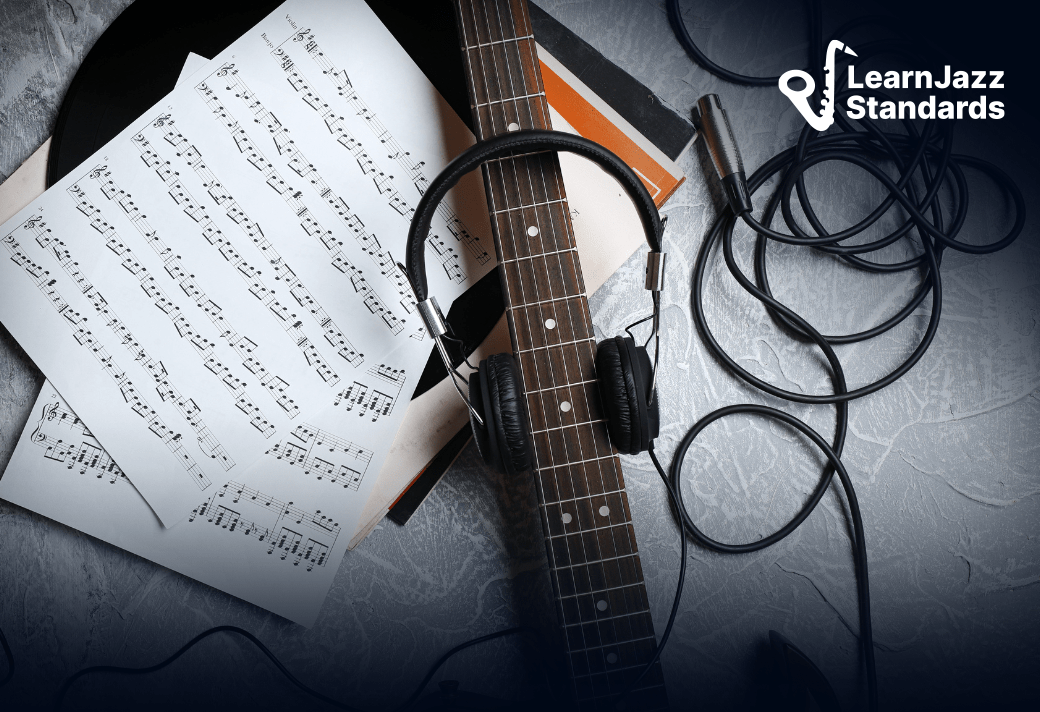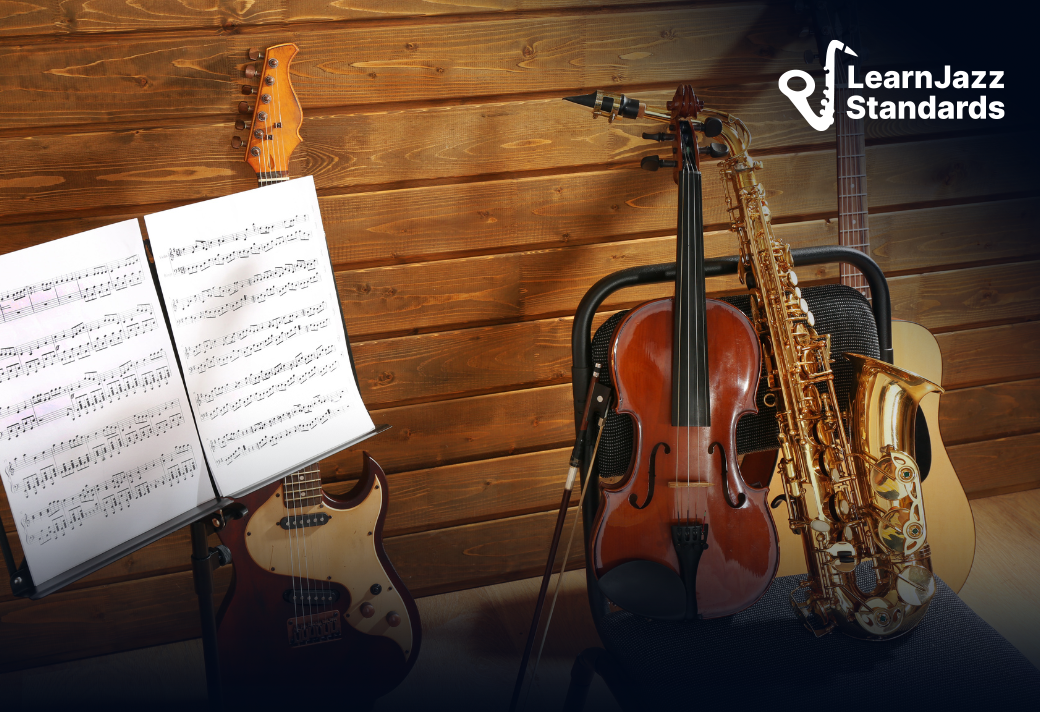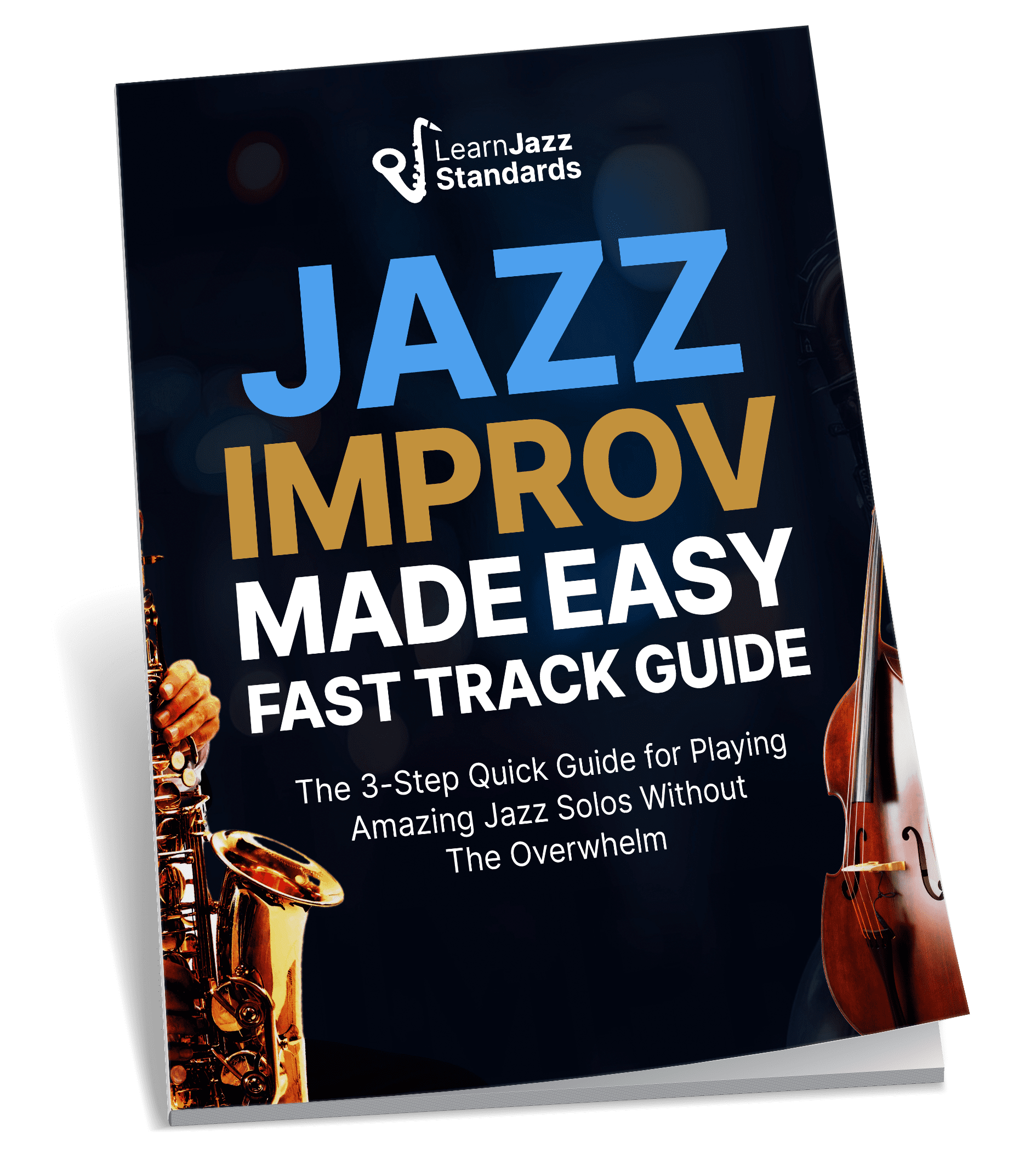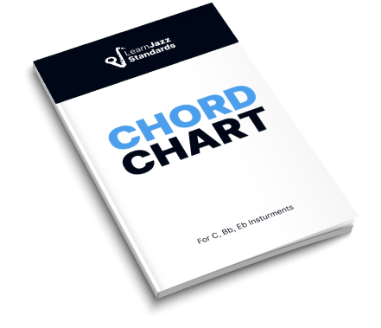Whether you’ve been playing jazz guitar for a while or are new to jazz music, one thing you’ll most definitely need to take your jazz guitar playing to the next level is a solid understanding of jazz guitar chords.
In this article, we’ll introduce you to essential jazz guitar chord shapes to help you expand your jazz chord vocabulary.
These jazz guitar shapes can be played over virtually any jazz tune, meaning once you have these jazz chords down, you’ll be ready to sit in with the rhythm section at the next jam session.
We’ll break down—
- Basic 7th chord theory
- Jazz guitar Chord Inversions
- Essential Major 7th jazz guitar chord shapes
- Essential Minor 7th jazz guitar chord shapes
- Essential Dominant 7th jazz guitar chord shapes
- Essential Half-Diminished and Fully-Diminished 7th jazz guitar chord shapes
- What makes jazz guitar chords unique?
- Jazz chord practice tips for every jazz guitarist
- Plus, jazz guitarists you need to listen to
You’ll need a practice plan if you want to play jazz guitar like Pat Metheny, John Scofield, Joe Pass, Wes Montgomery, or Jim Hall. If you are spending hours noodling on your guitar and not seeing results when you go to play jazz guitar, then perhaps you need to overhaul how you practice.
When you join the Inner Circle, you unlock a clear pathway toward jazz guitar mastery—
- You’ll build a personalized practice plan that fills in the gaps in your jazz guitar knowledge, improvisation, musicianship, and jazz guitar playing style.
- You’ll take a deep dive into a new jazz standard every month to improve your jazz repertoire and jazz vocabulary.
- You’ll get personalized guitar instruction via our Jazz Guitar Accelerator Courses, which will help you achieve technical mastery.
- You’ll join a community of avid jazz musicians who love jazz just as much as you do.
Practice Smarter, Not Harder. Join the Inner Circle today!
Table of Contents
20 Essential Jazz Guitar Chords To Improve Your Jazz Guitar Playing
If you learn these basic jazz chords, you’ll be well on your way to jazz guitar mastery. They work for any jazz style on the guitar—traditional jazz guitar, jazz fusion, blues, and modern jazz styles.
Internalizing these jazz chords (and jazz chord progressions) is a must if you want to play jazz at a higher level. Many guitarists ignore this extremely fundamental part of musicianship.
Not only are these chord types essential for playing jazz songs, but they’ll also help you find new lines and phrases when soloing over changes.
If you want to be the best jazz guitar player you can be, you shouldn’t put off learning jazz chords on guitar any longer!
Let’s start with some music theory basics! If this is a review for you, feel free to use the Table of Contents to skip right to the jazz chords!
What Are 7th Chords?
For the most part, jazz music uses tertian harmony, which means jazz chords are built on thirds (we’re leaving quartal harmony aside for this one). Most Western music uses triads to build chords. Triads are basic chords built from a root note with a 3rd and a 5th stacked on.
Here is a C major triad:
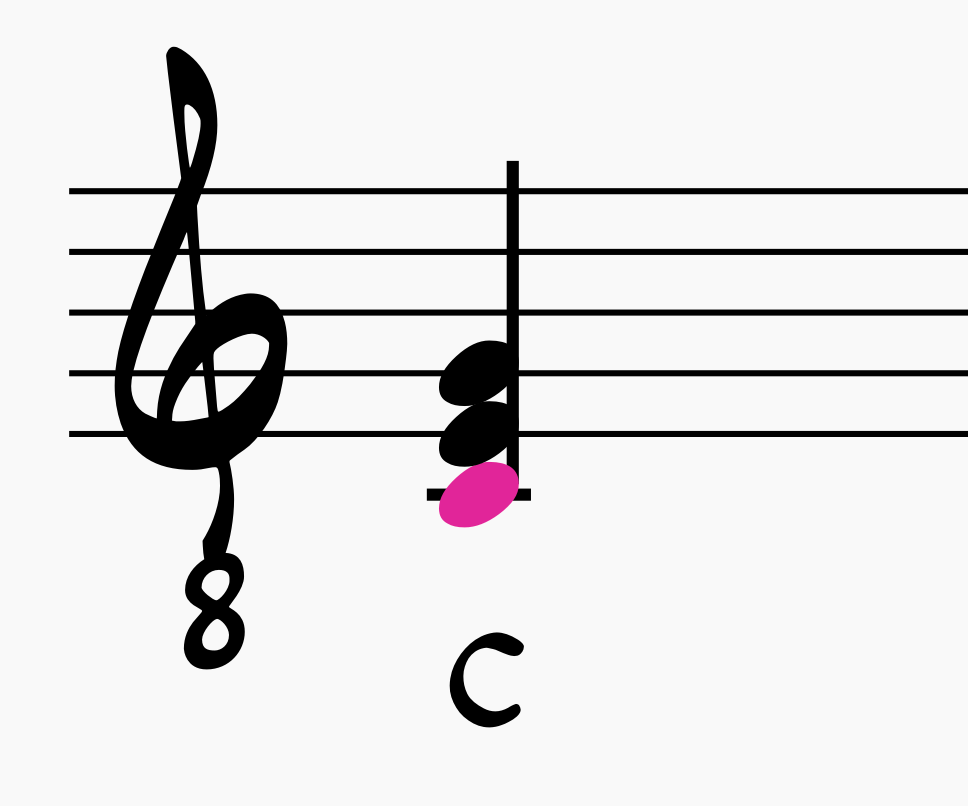
- C – E – G
- Root, 3rd, 5th
7th chords add an additional piece of harmonic information into the mix (either a major or a minor 7th interval from the root). This gives us a four-note chord.
Here is a C major seventh chord:
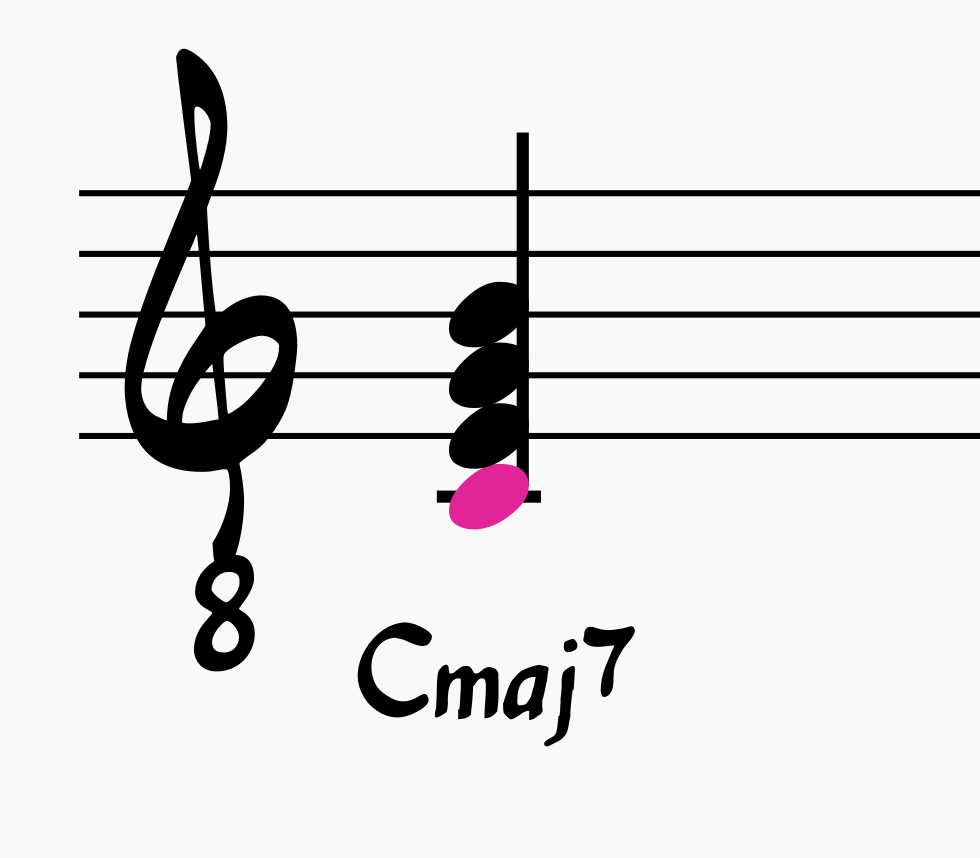
- C – E – G + B
- Root, 3rd, 5th + 7th
Adding a B to a C major triad gives us a C major seventh chord.
You alter the chord quality when you change the distance of the 3rd, 5th, or 7th note from the root note. For example, here is a C-7 chord:
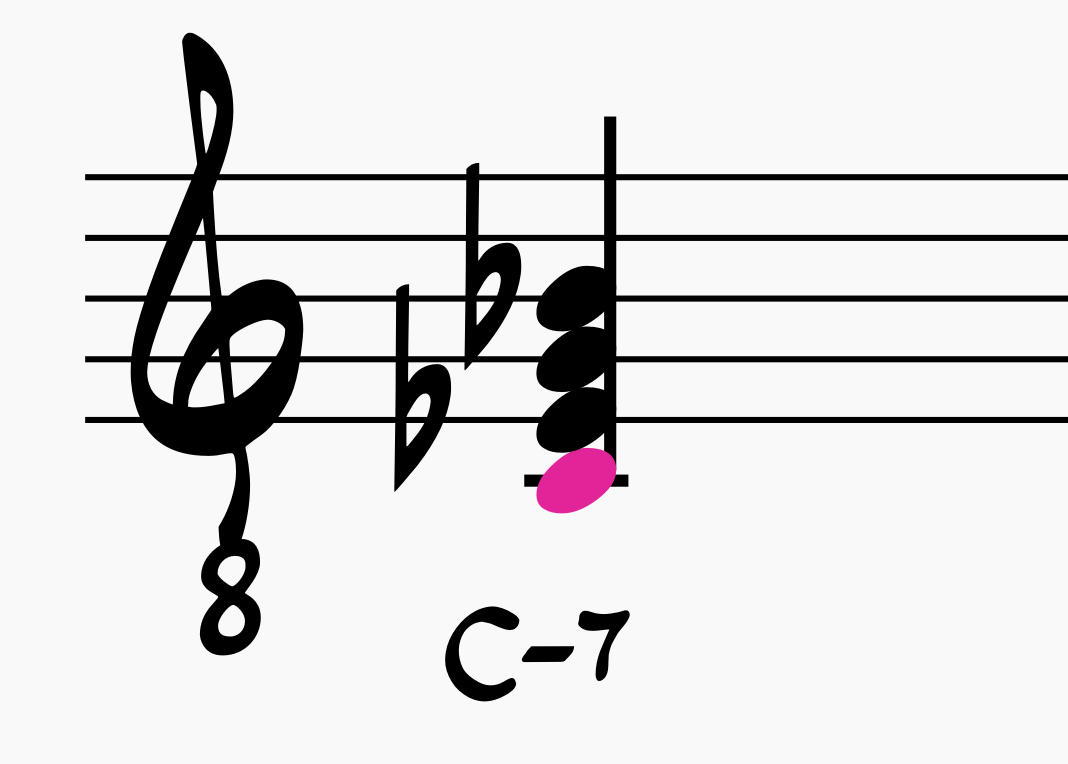
Notice how the 3rd and the 7th were diminished by one half-step.
Changing one or more chord tones gives you various minor jazz chords, dominant jazz chords, half-diminished jazz chords, and fully diminished jazz chords.
Jazz Guitar Chord Inversions
Root position jazz chord shapes are great, but they aren’t always practical in a performance situation—especially on guitar!
That’s why you also need to learn jazz guitar chord inversions when learning jazz chords.
Let’s take one major 7th chord voicing and take it through all its inversions to demonstrate how to do this. This particular major chord sits on the A string, D string, G string, and B string. We’ll stick to this string group for all its inversions.
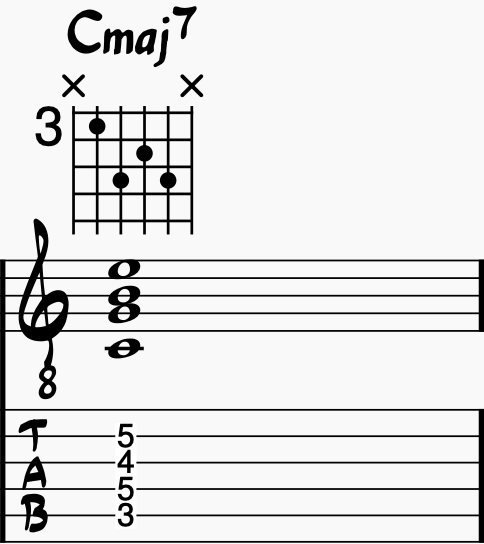
To bring this chord shape into its first inversion, we must move each chord tone up to the next chord tone. For example:
- C (root) must move to E (3rd)
- E (3rd) must move to G (5th)
- G (5th) must move to B (7th)
- B (7th) must move to C (root)
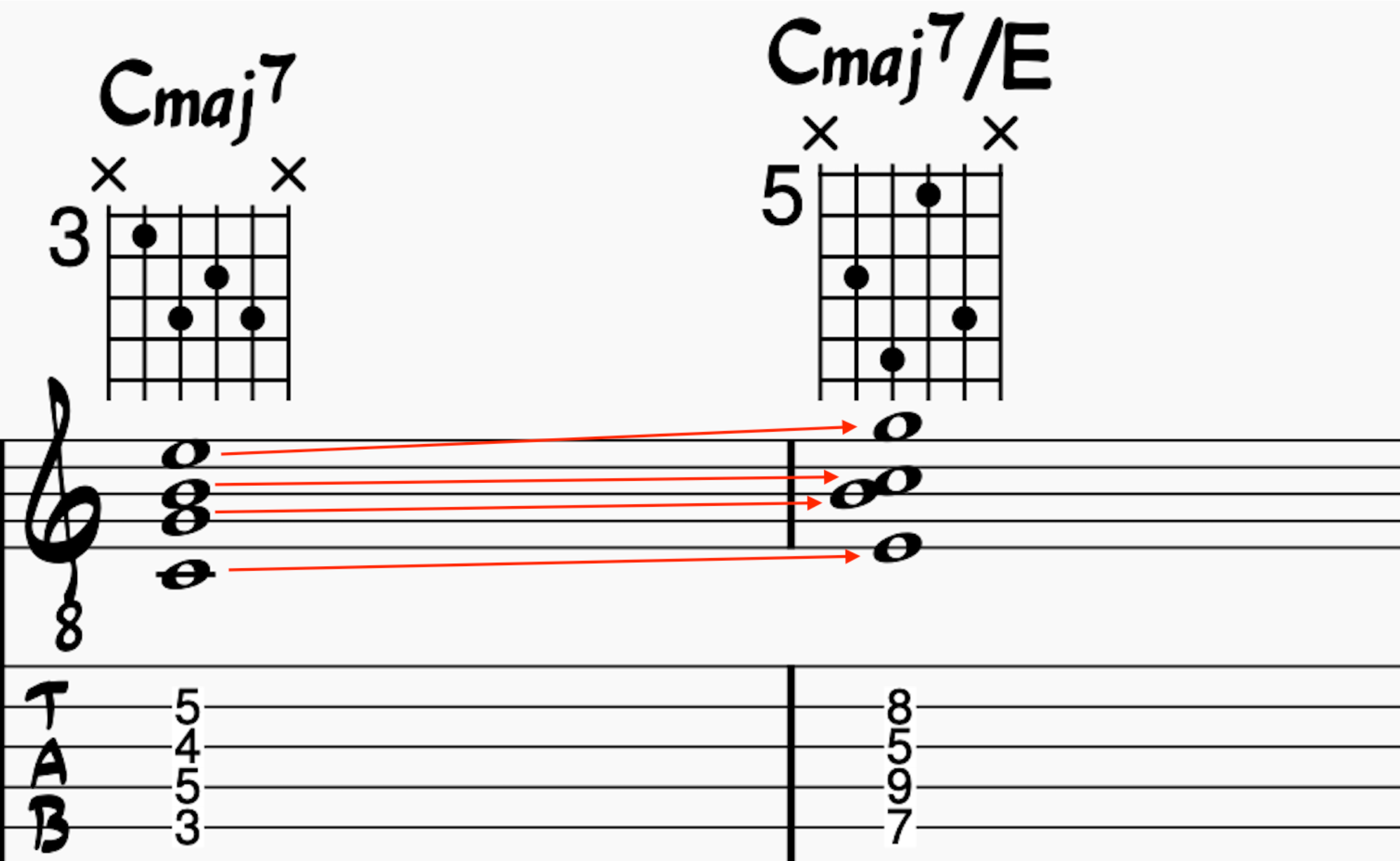
Let’s continue the process:

When you know all the inversions of any jazz guitar chord shape, you’ll never get stuck when comping or soloing over a jazz standard.
7th Chord Takeaways:
- Though they will be given in one key, you should take the following easy jazz chords through all other keys to get comfortable with these shapes in different positions on the guitar neck.
- In music theory, most 7th chords are spelled out in the root position. However, in practice, root-position chords aren’t as common on guitar as they might be on piano. Sometimes, the bass note (lowest note) isn’t the root note. When this happens, the chord is inverted.
- Some of the following voicings will have extensions, which may look strange if you’ve never encountered them. You’ll see voicings with a 6th, 9th, 11th, or 13th. On guitar, sometimes consonant chord tones like the 5th are replaced by an extension because we only have so many fingers!
- Sometimes, the extended notes are altered. These are called altered extensions.
Check out our ultimate guide to 7th chords if you want a more comprehensive breakdown.
Now we’re ready to dive into these 20 essential jazz guitar chords!
Jazz Guitar Chords: 5 Major Seventh Chord Voicings and Inversions
In jazz theory, major 7th jazz chords are built like this:
- Root
- major third
- perfect fifth
- major seventh
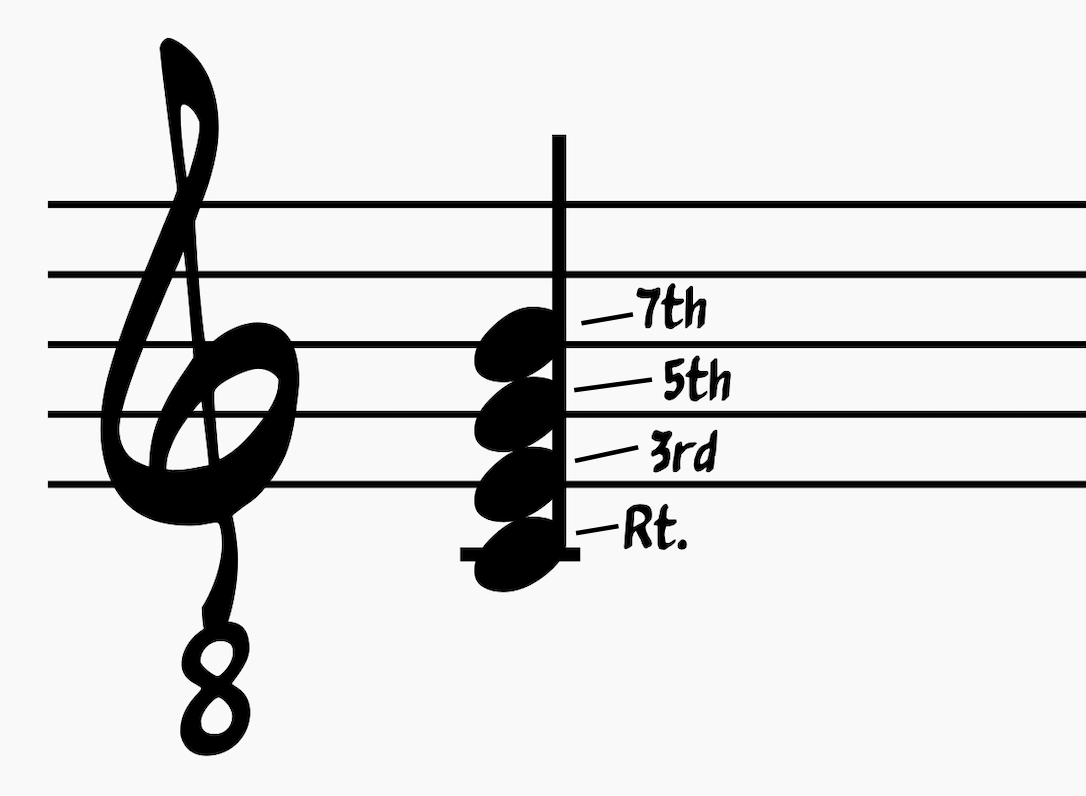
Another way to think about major seventh chords is to take a major triad and add a major seventh from the root note.
- Major Triad + Major 7th = Maj7 Chord
There are a few common chord extensions that major 7th chords can have in jazz music:
- 6th
- 9th
- #11th
- 13th (an octave higher than the 6th)
Here are five essential major seventh chords you need to internalize. Be sure to check out the chord diagrams, too!
1. E-D-G-B String Major 7 Chord (Gmaj7)
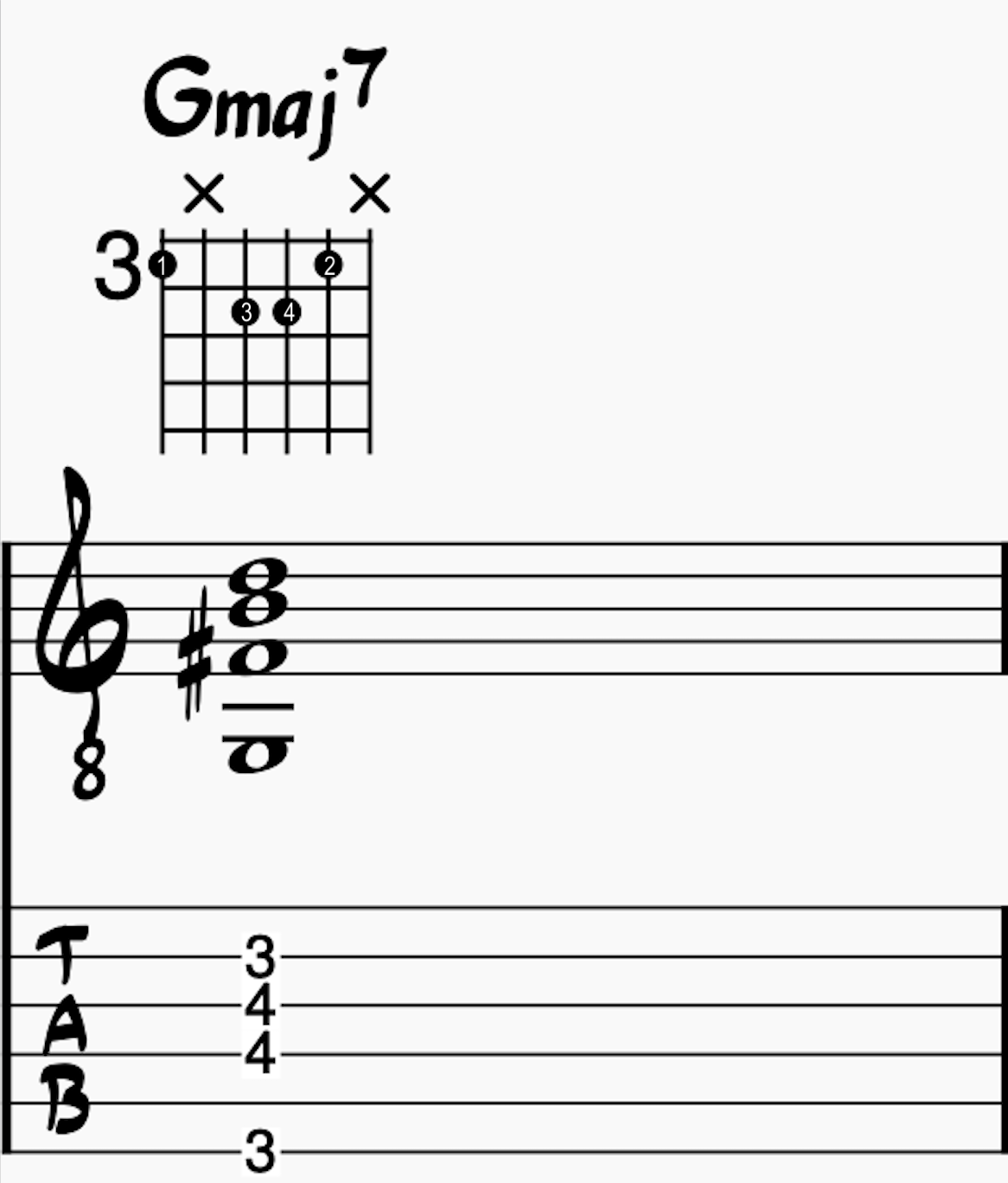
Here are the chord inversions for this jazz guitar chord:
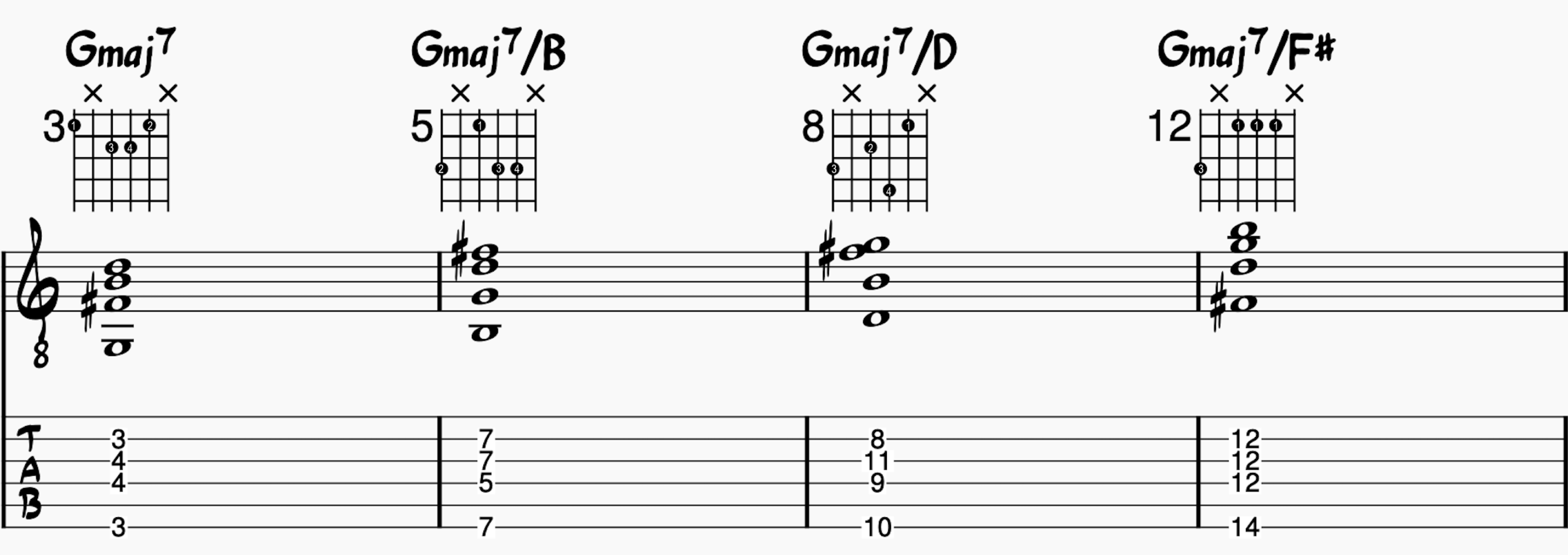
2. A-D-G-B String Group Major 7 Chord (Cmaj7)
We’ve already seen this jazz guitar chord in a previous section, but here it is again for thoroughness!
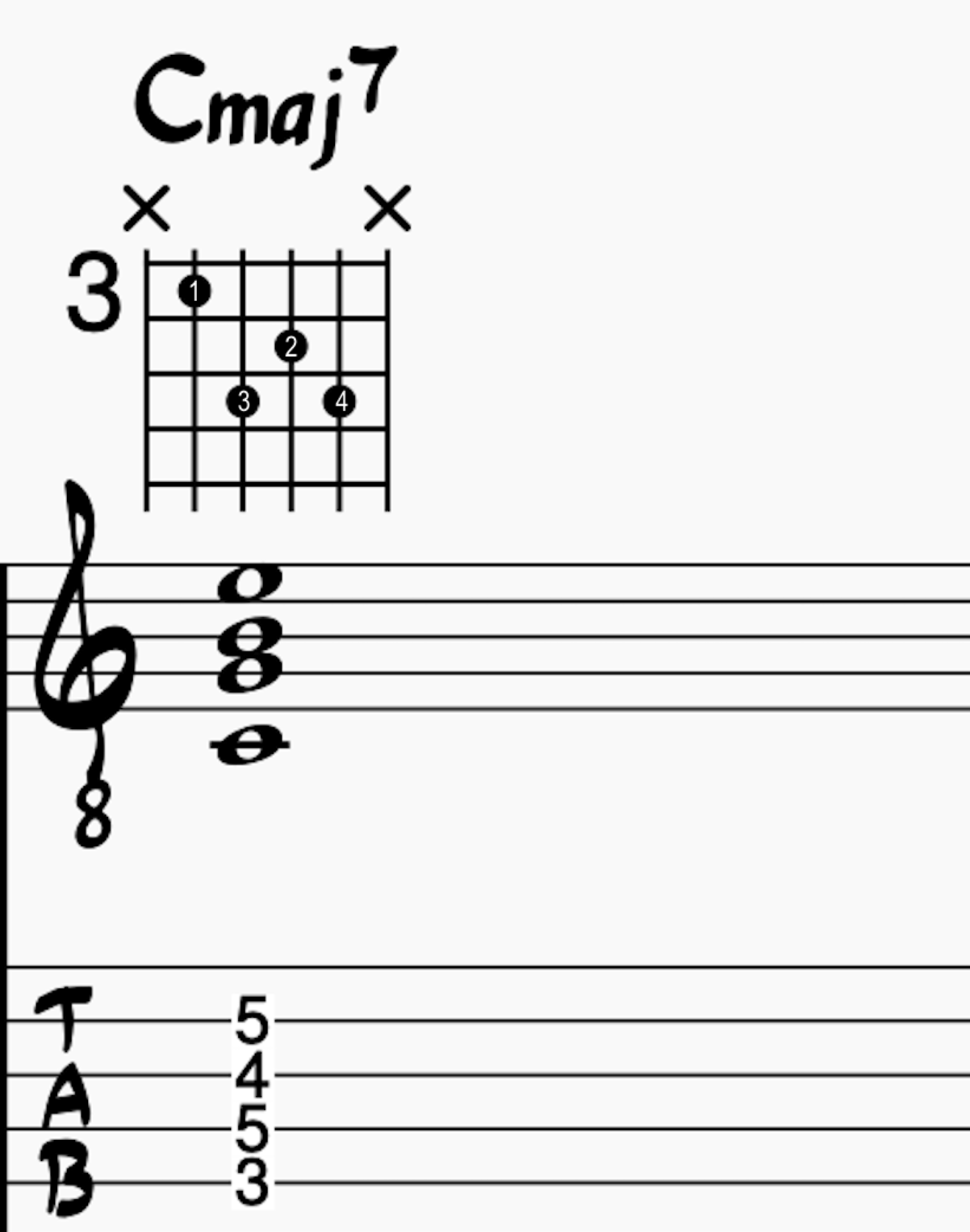
Here are all the guitar chord inversions for this A-D-G-B string Maj7 chord:
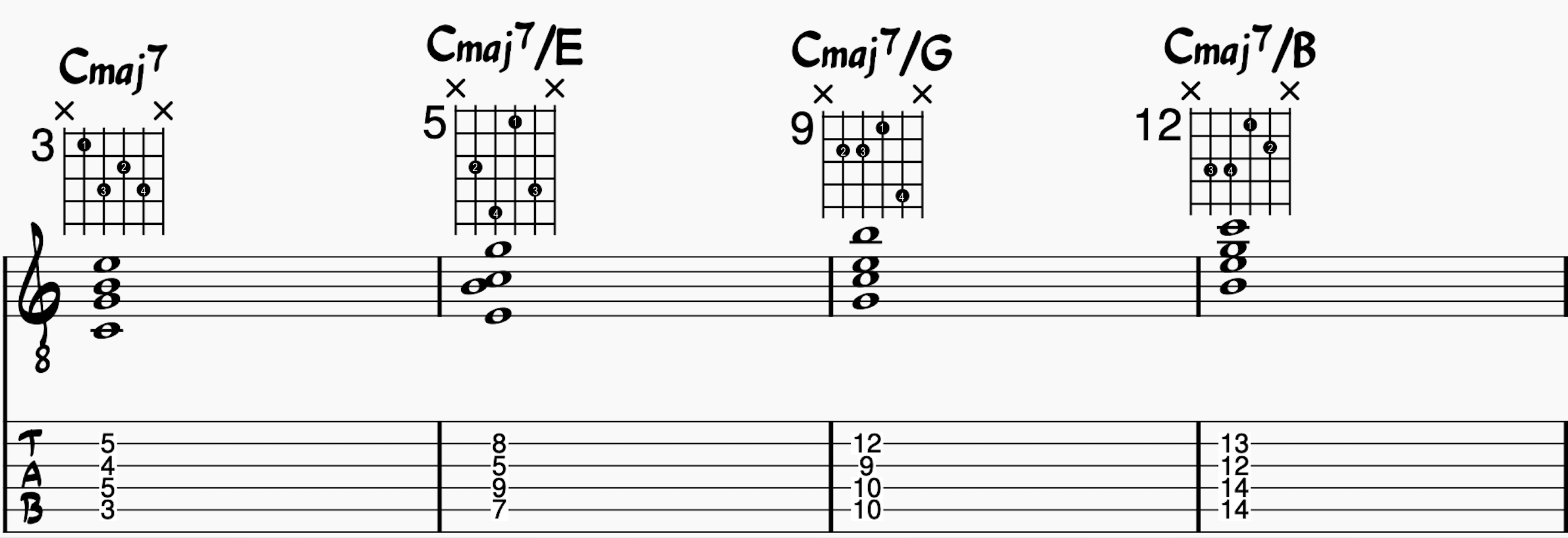
3. D-G-B-E String Group Major 7 Jazz Guitar Chords (Fmaj7)
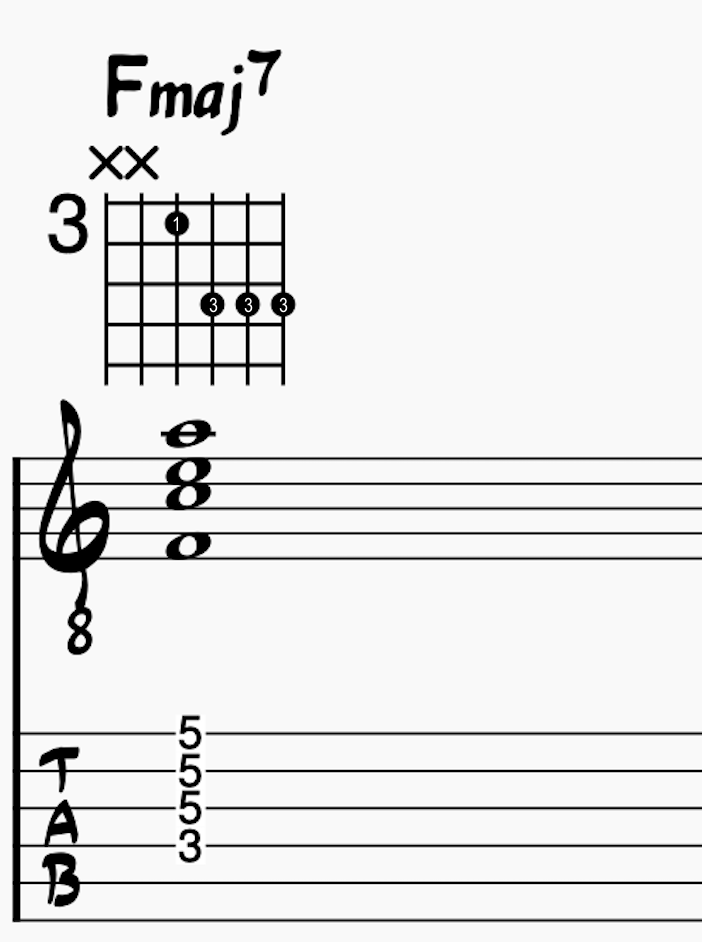
Here are all the inversions for this chord type:
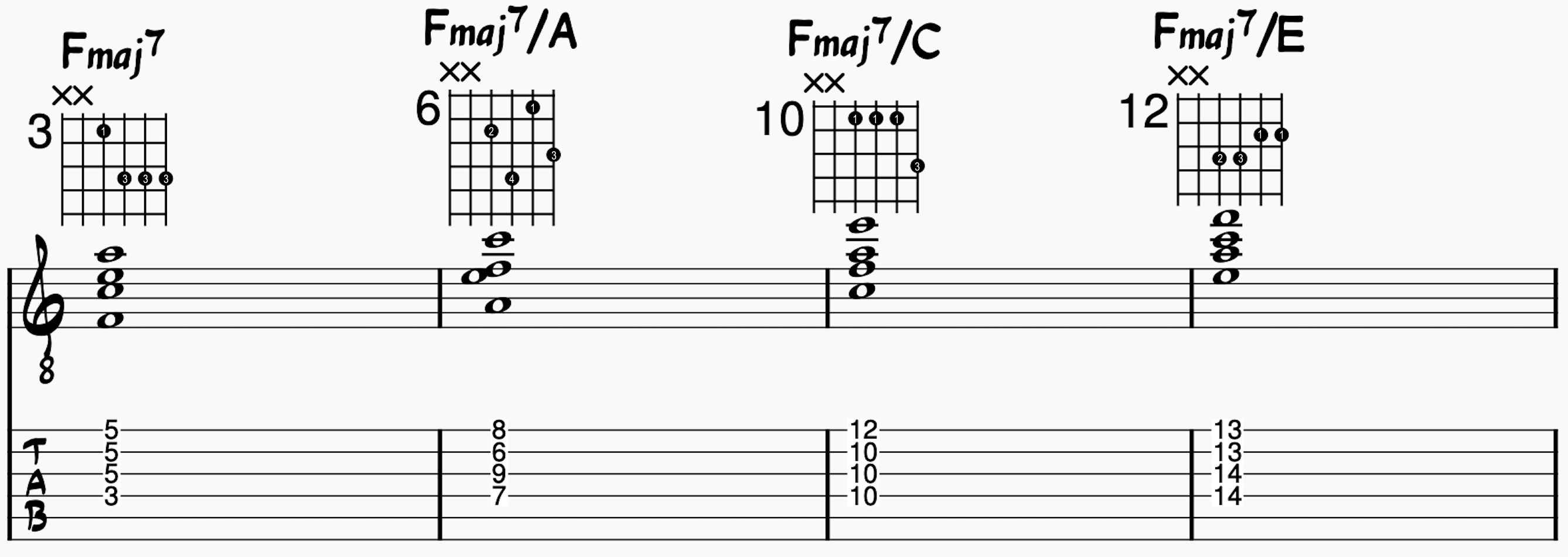
4. A-D-G-B String Group Major 9 Jazz Guitar Chords (Cmaj9)
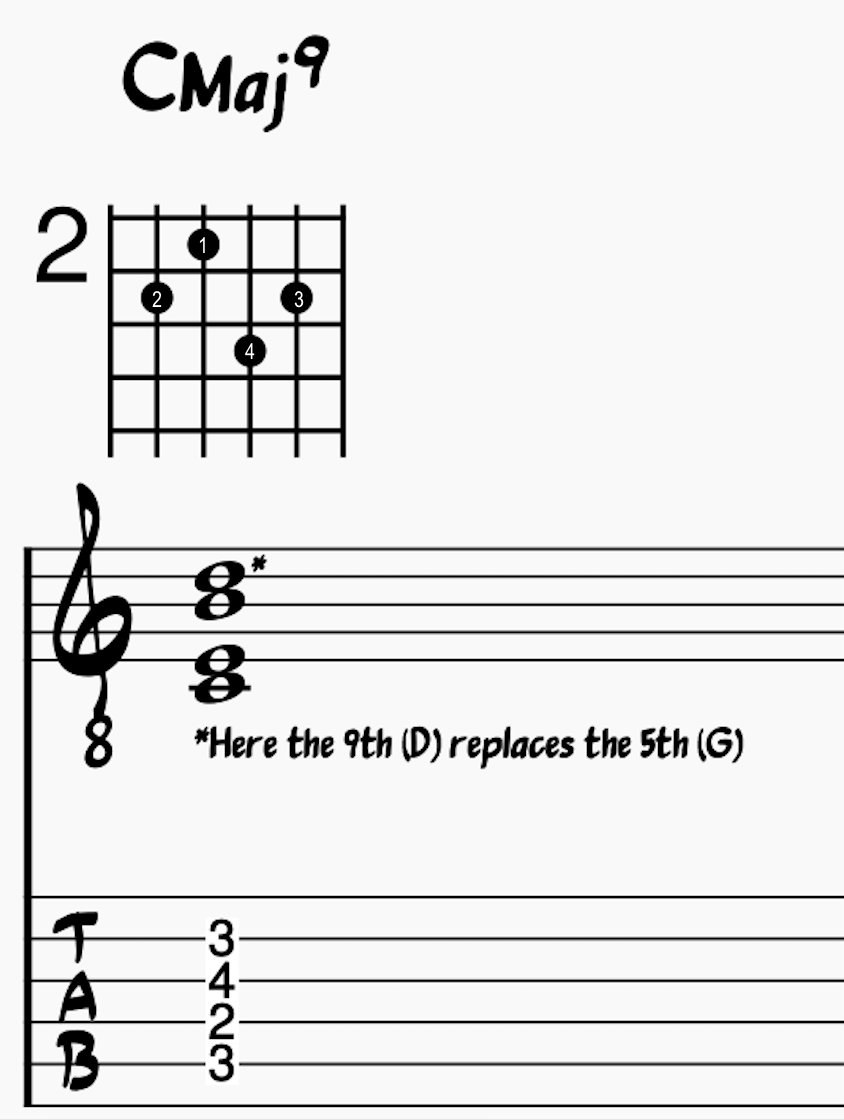
Interesting things start to happen when you take these chords through their inversions. On the staff, it’s possible to take any chord through all its inversions. However, the physical nature of the guitar makes this challenging for some voicings, and something has got to give.
For example, to physically play the chord, we have to replace another note. I chose to replace the root (C) with the 9th (D). When we find the right fingering, we end up playing an E-7 chord! However, this is totally fine! All the notes work out.
If a bass player is in the group, you don’t have to worry about playing any bass notes.
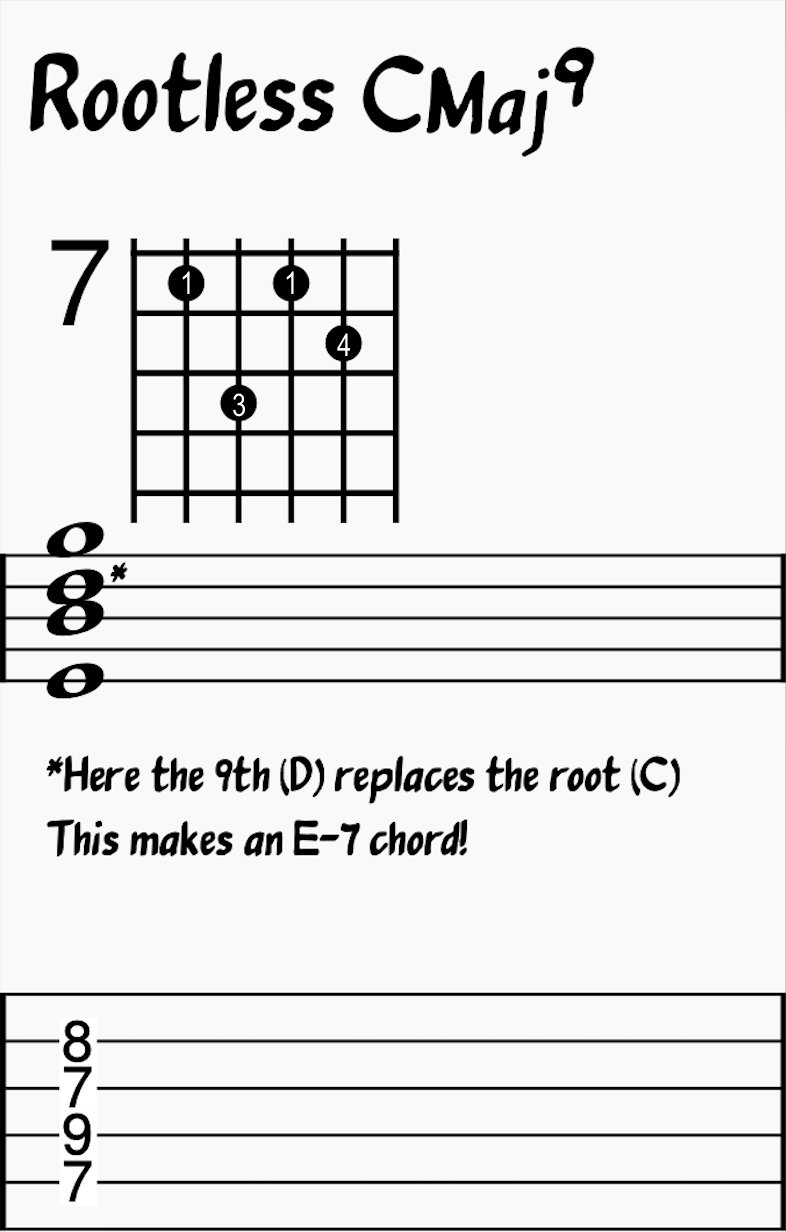
Move the 9th (D) in this voicing back down to the root, and you end up with this Cmaj7/E voicing we discussed above:
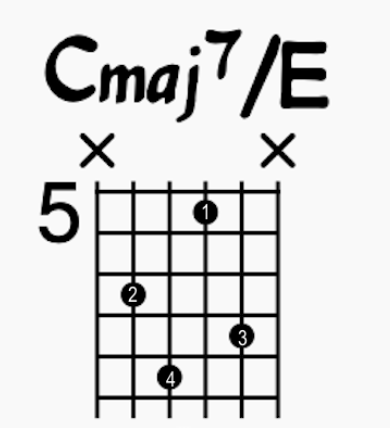
5. E-D-G-B String Group Major 6 Jazz Guitar Chords (Gmaj6)
This maj6 voicing is very common on guitar. However, upon closer inspection, it’s a 1st inversion E-7 chord!
The notes from lowest to highest are:
- D = 7th of E-7
- B = 5th of E-7
- E = Root of E-7
- G = 3rd of E-7
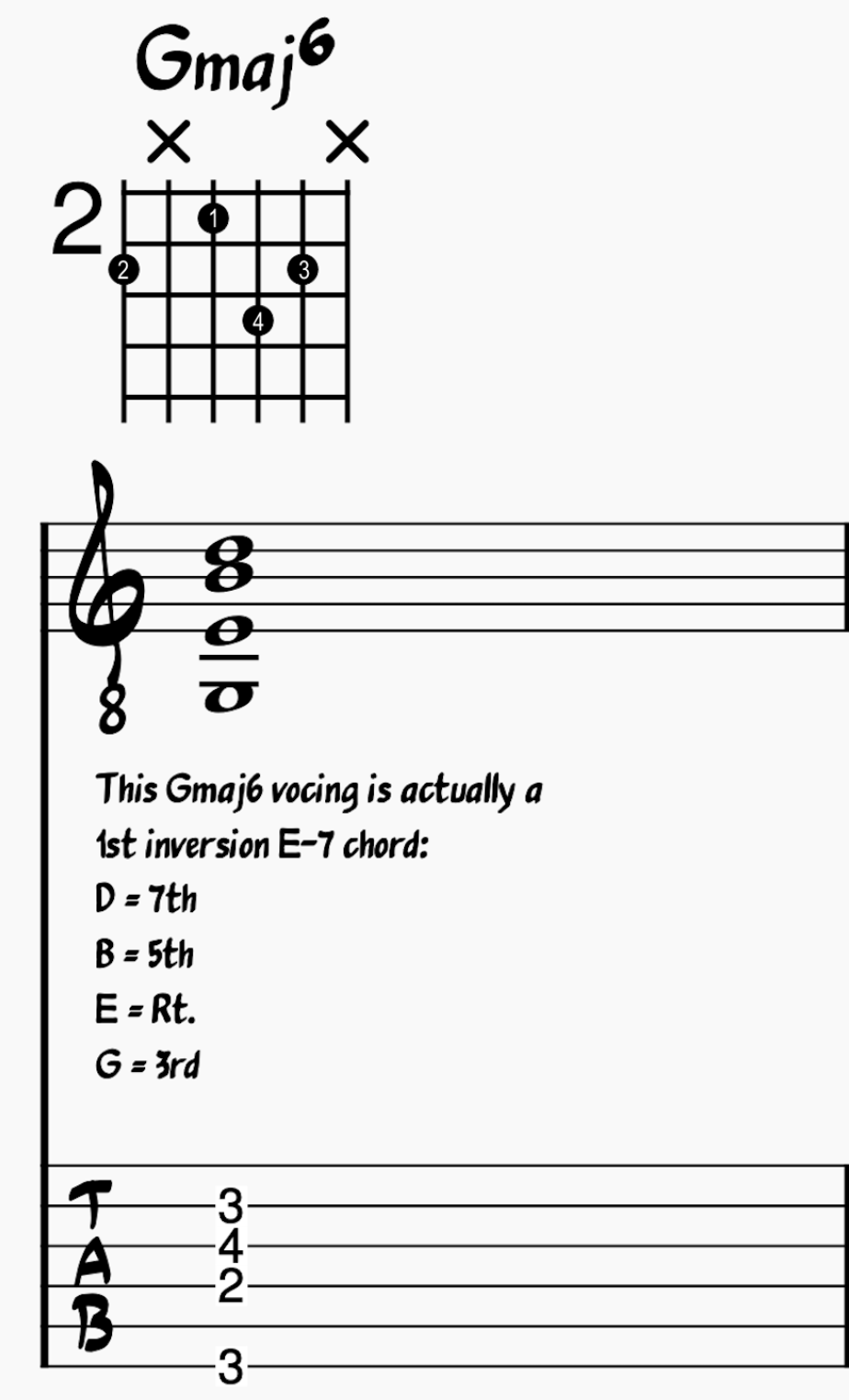
You can use minor 7th chord shapes to play relative major chords with an added 6th.
To learn more, check out our blog post on major 7th voicings and inversions on the guitar.
Jazz Guitar Chords: 5 Minor Seventh Chord Shapes
In jazz theory, a minor seventh chord is built like this:
- Root
- minor third
- perfect fifth
- minor seventh
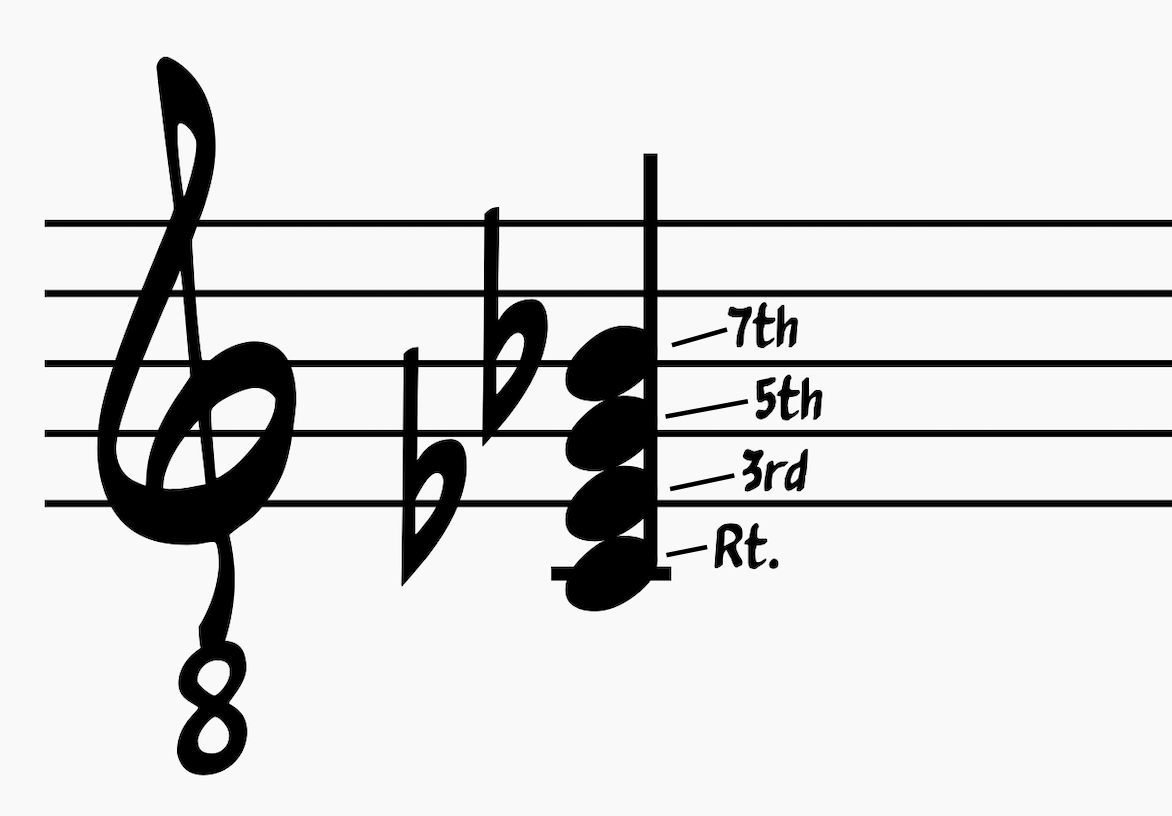
Another way to think about minor seventh chords is to take a minor triad and add a minor seventh from the root note.
Common chord extensions on minor seventh chords are:
- 6th
- 9th
- 11th
- 13th
Here are five essential minor seventh-chord voicings you need to internalize. Check out the chord diagrams:
6. A-D-G-B String Group Minor 9 Jazz Guitar Chords
This is one of my favorite guitar chord shapes! It’s perfect as the ii chord in minor ii-V-i chord progressions and major ii-V-I chord progressions.
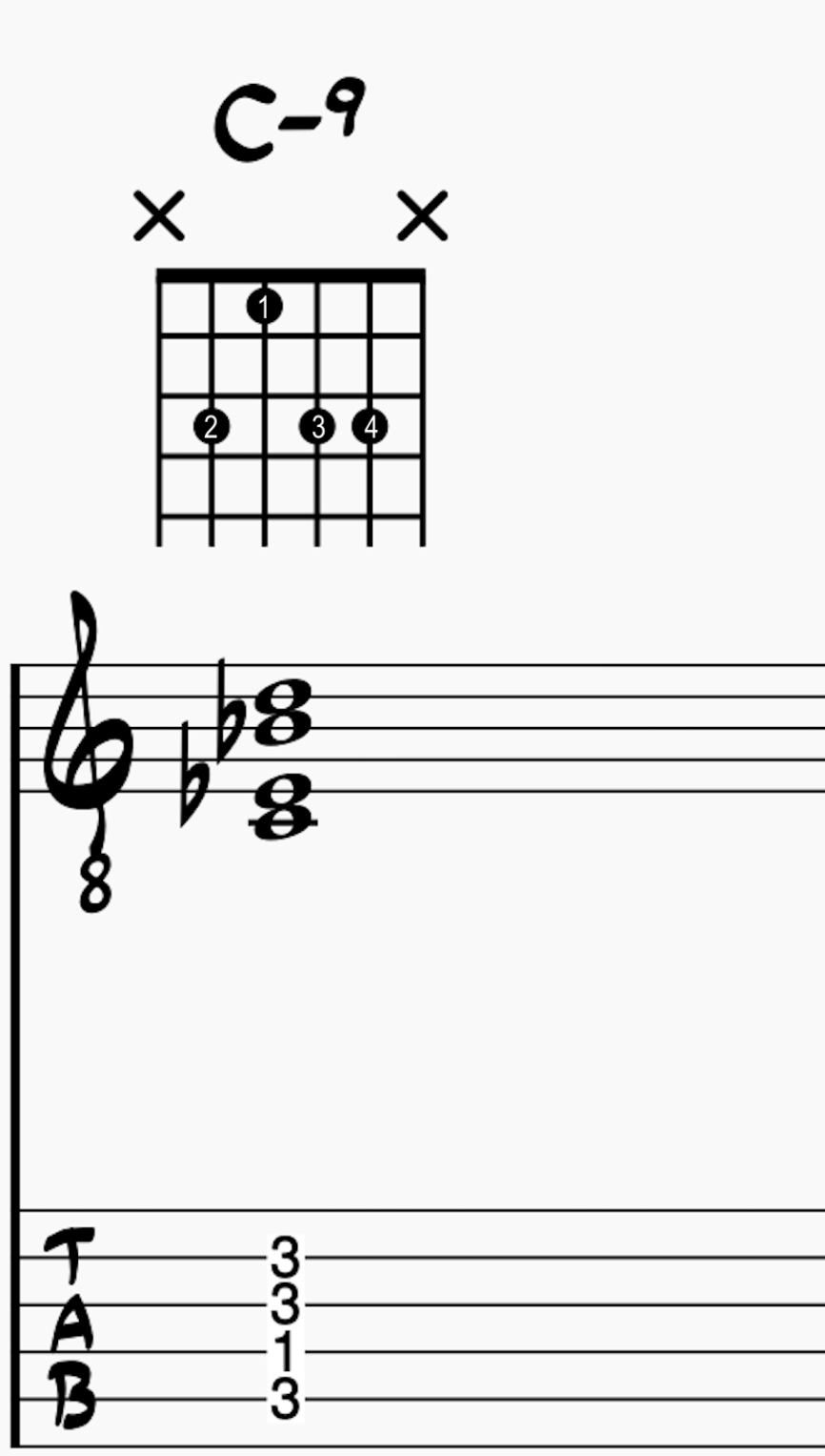
This minor 9 chord shape works really well in the following major ii-V-I progression. These particular voicings work very well together. Notice how the D is the top voice in each chord shape:
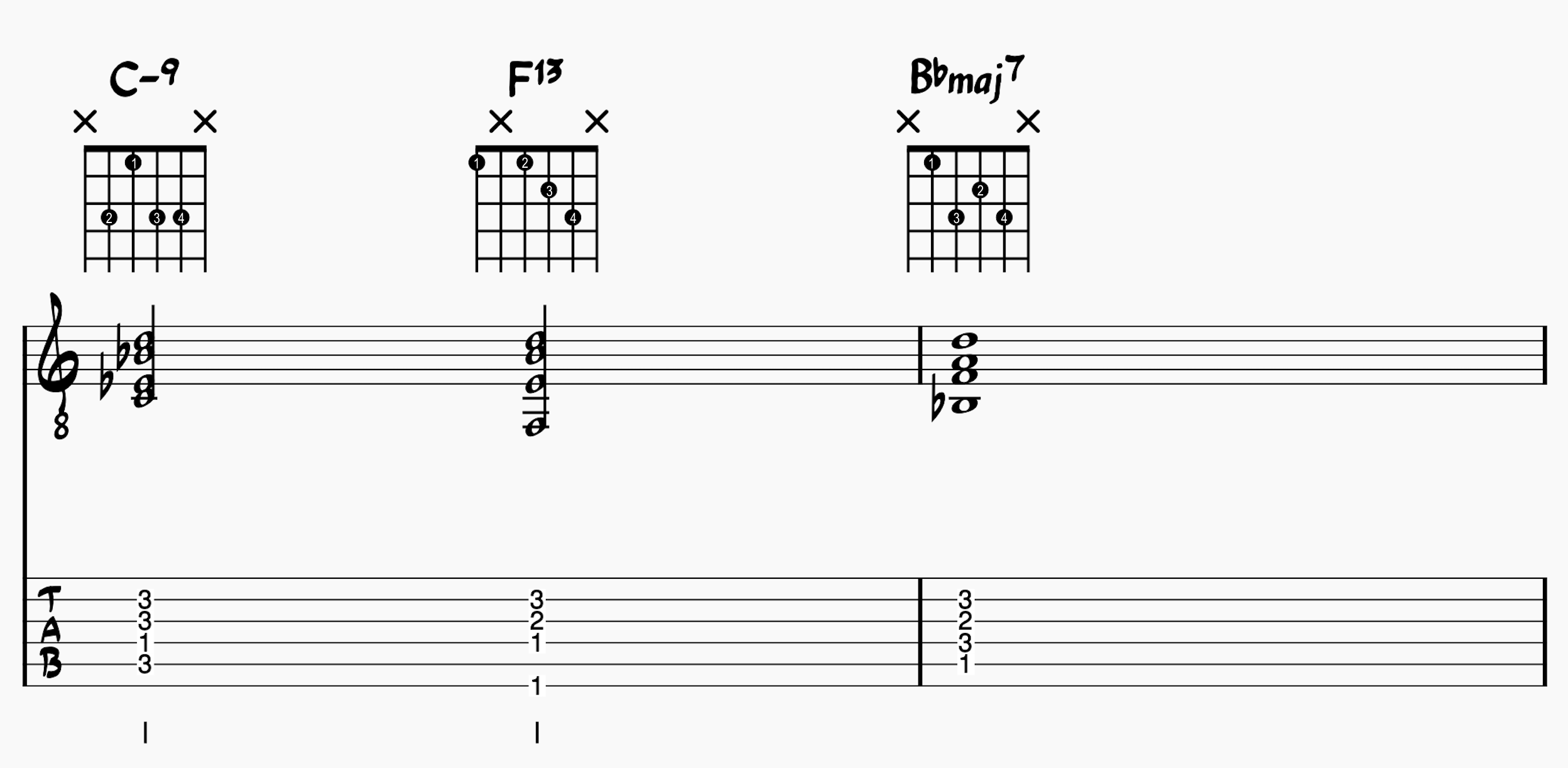
7. E-D-G-B String Group Minor Seven Jazz Guitar Chords
This is another min7 voicing that you’ll use again and again. You should take this particular min7 chord shape through its inversions (you’ll recognize the 1st inversion shape as the maj6 chord shape covered above).
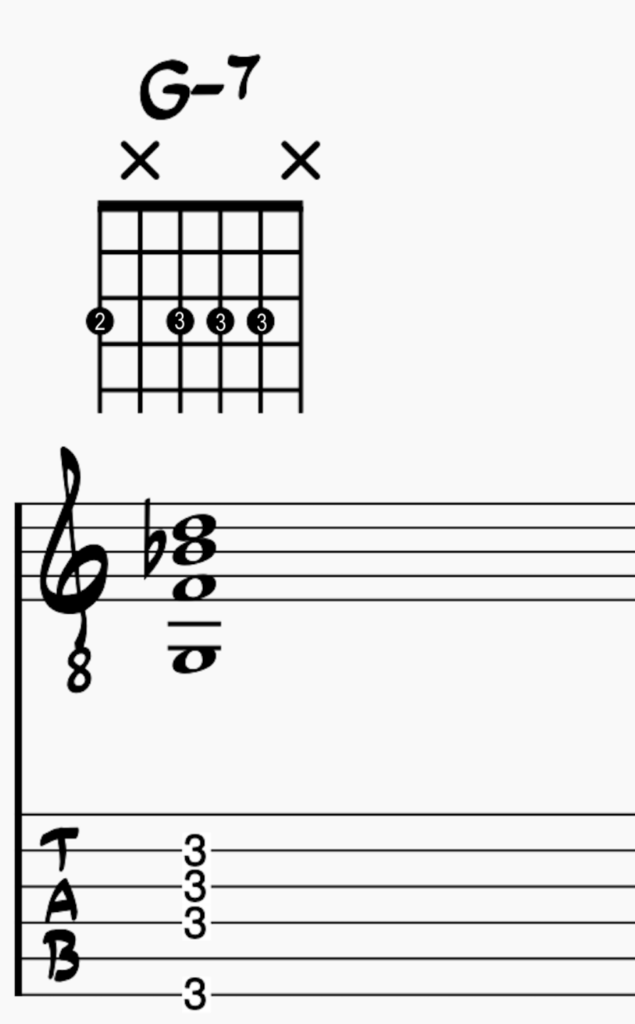
Here are the inversions for this E-D-G-B string group minor seventh chord:
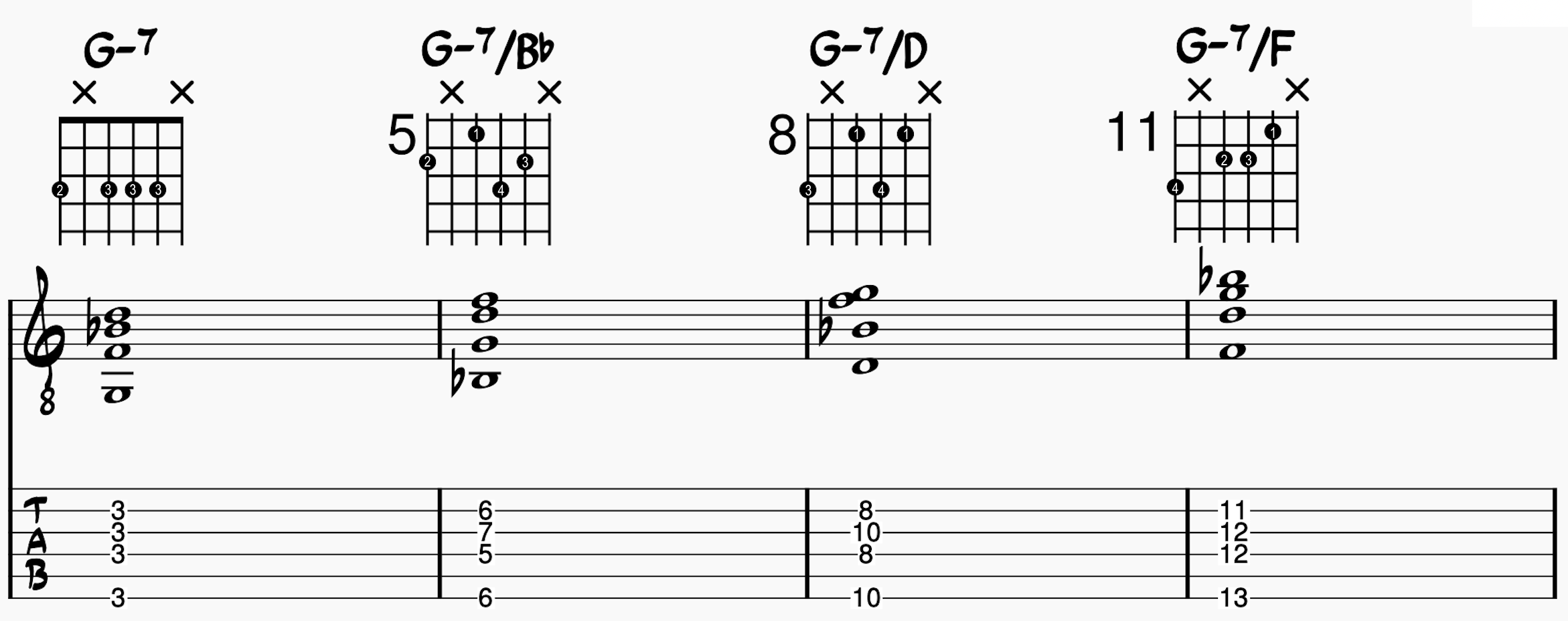
8. D-G-B-E String Group Minor 9 Jazz Guitar Chords
This A-9 chord shape might look familiar…
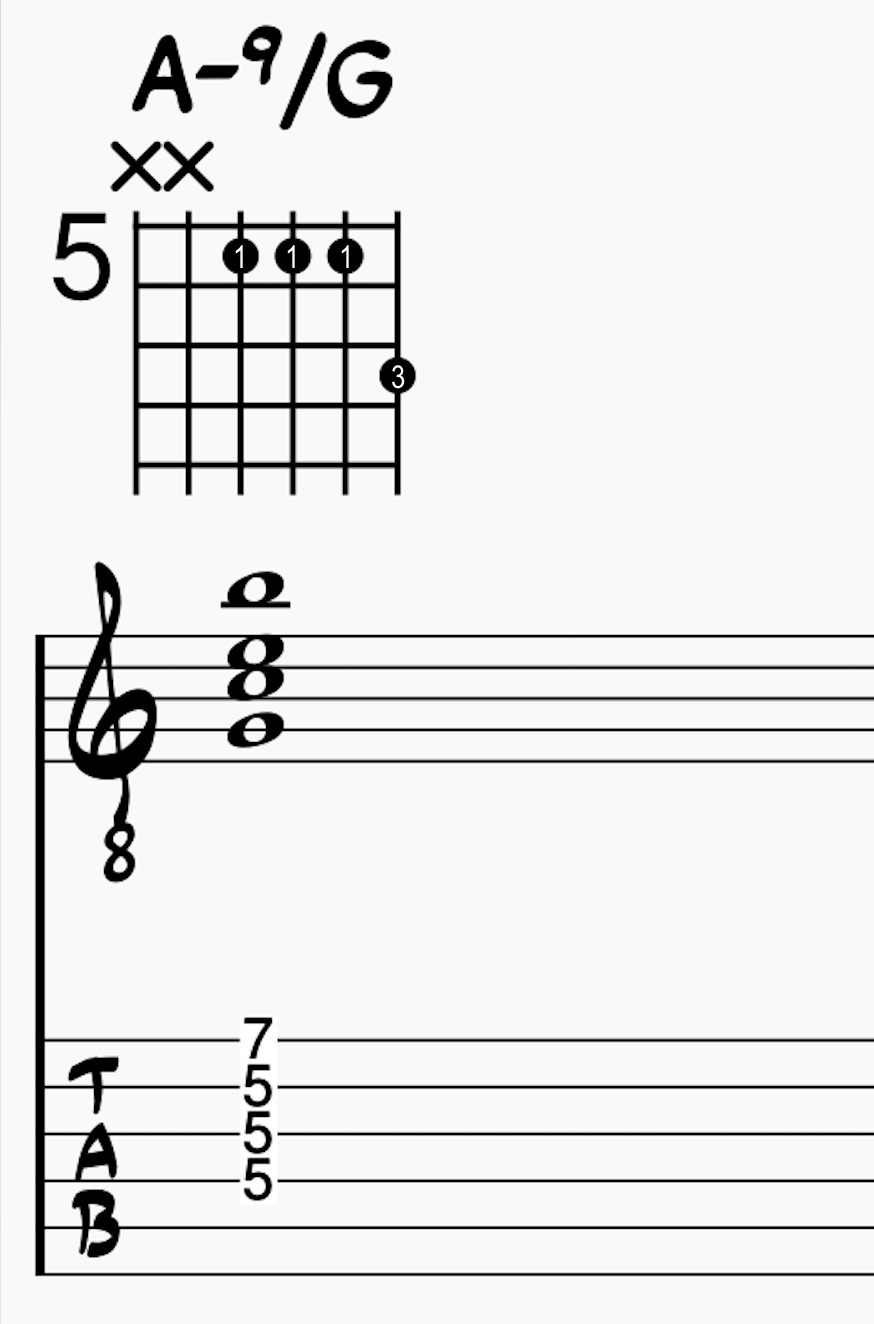
This min9 chord shape is the same as this maj7 chord shape (disregard the chord notes; we’re looking at the chord shape).
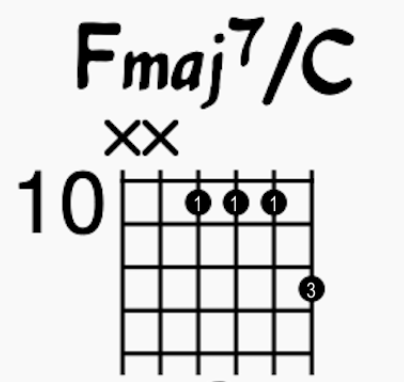
This A-9 chord voicing has all the same notes as a Cmaj7/G chord voicing. Here is another relative major and minor chord voicing relationship (see Maj6 chords above)!
Cmaj7/G
- B = 7th
- E = 3rd
- C = Root
- G = 5th
A-9/G
- B = 9th
- E = 5th
- C = 3rd
- G = 7th
9. E-D-G-B String Group Minor 11th Jazz Guitar Chords
This min11 chord shape is another one of my favorites. Many jazz compositions use a natural 11 over a minor chord, so knowing this shape and others like it is important (plus, it just sounds good).
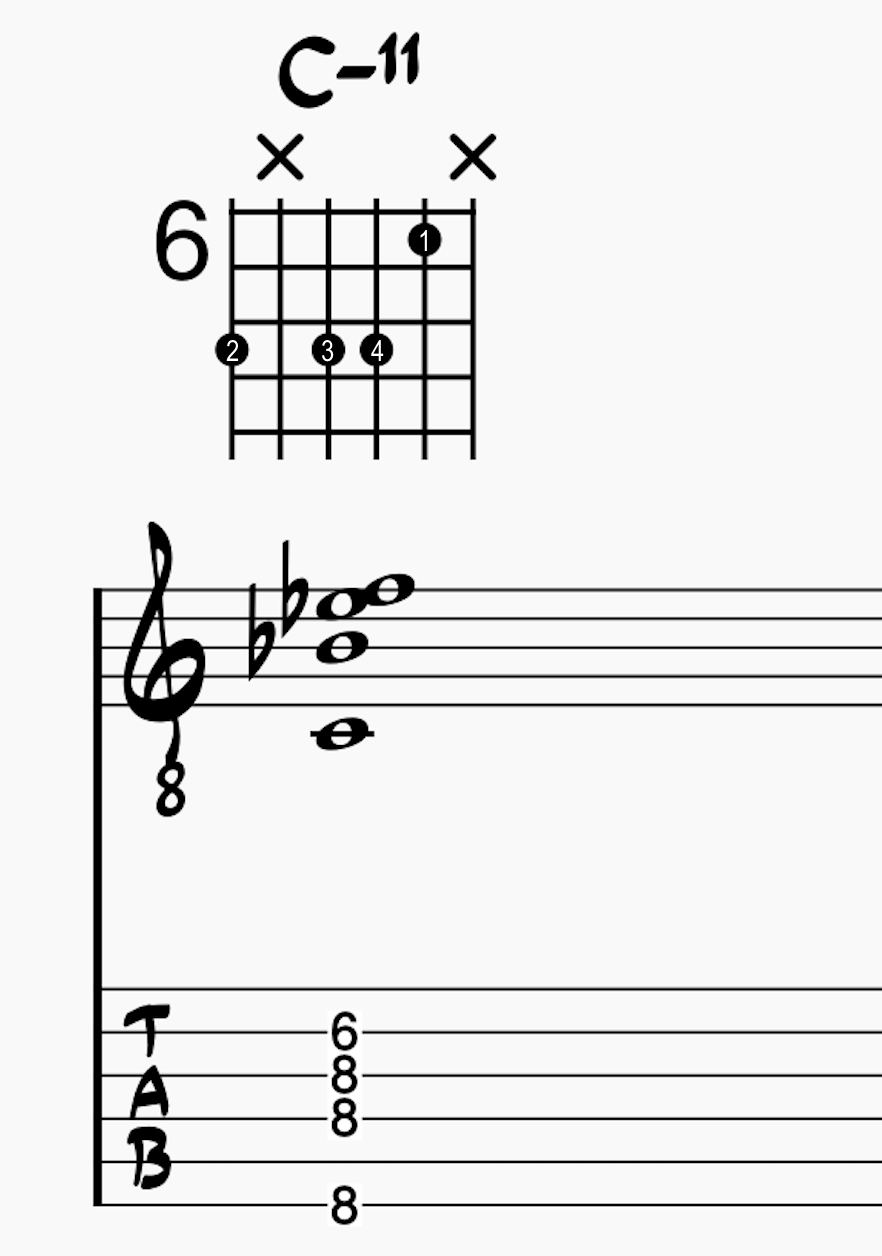
10. A-D-G-B String Group Minor 7 Jazz Guitar Chords
This is another minor 7th guitar chord staple. Take this one through all its inversions, too.
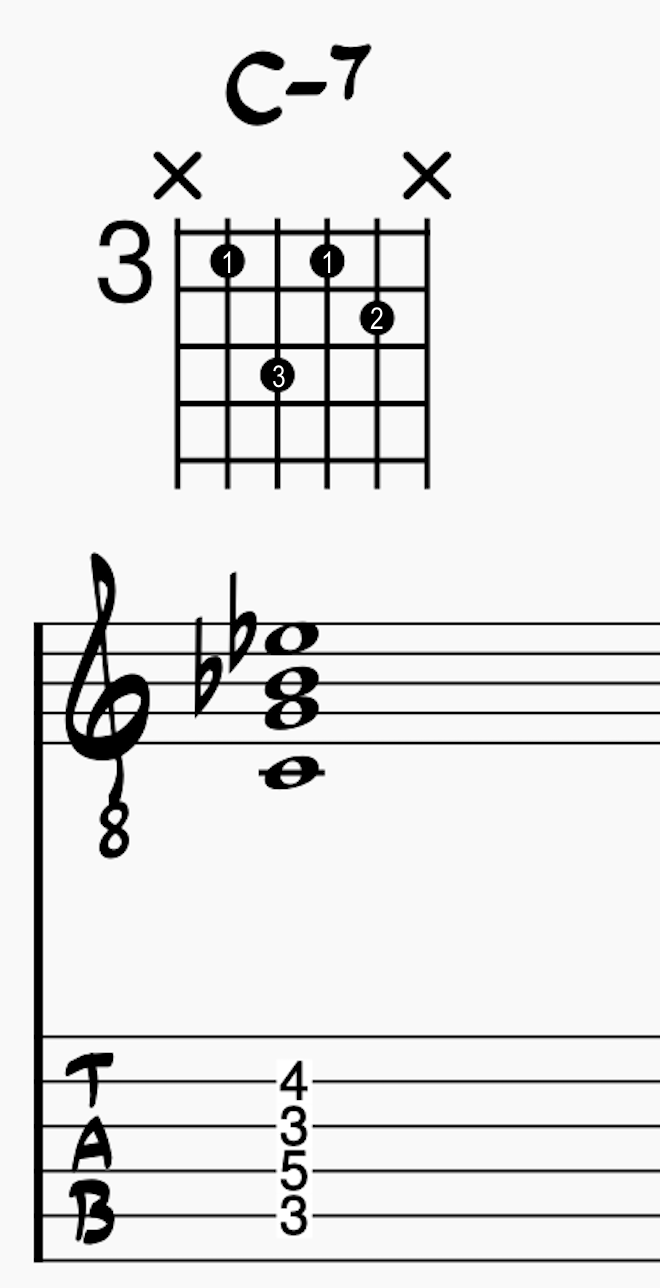
For more minor seventh chords, check out our blog post on minor 7th voicings and inversions on the guitar.
BEFORE YOU CONTINUE...
If music theory has always seemed confusing to you and you wish someone would make it feel simple, our free guide will help you unlock jazz theory secrets.

Jazz Guitar Chords: 5 Dominant Chords
Dominant 7th chords are built using this formula:
- Root
- major 3rd
- perfect 5th
- minor 7th
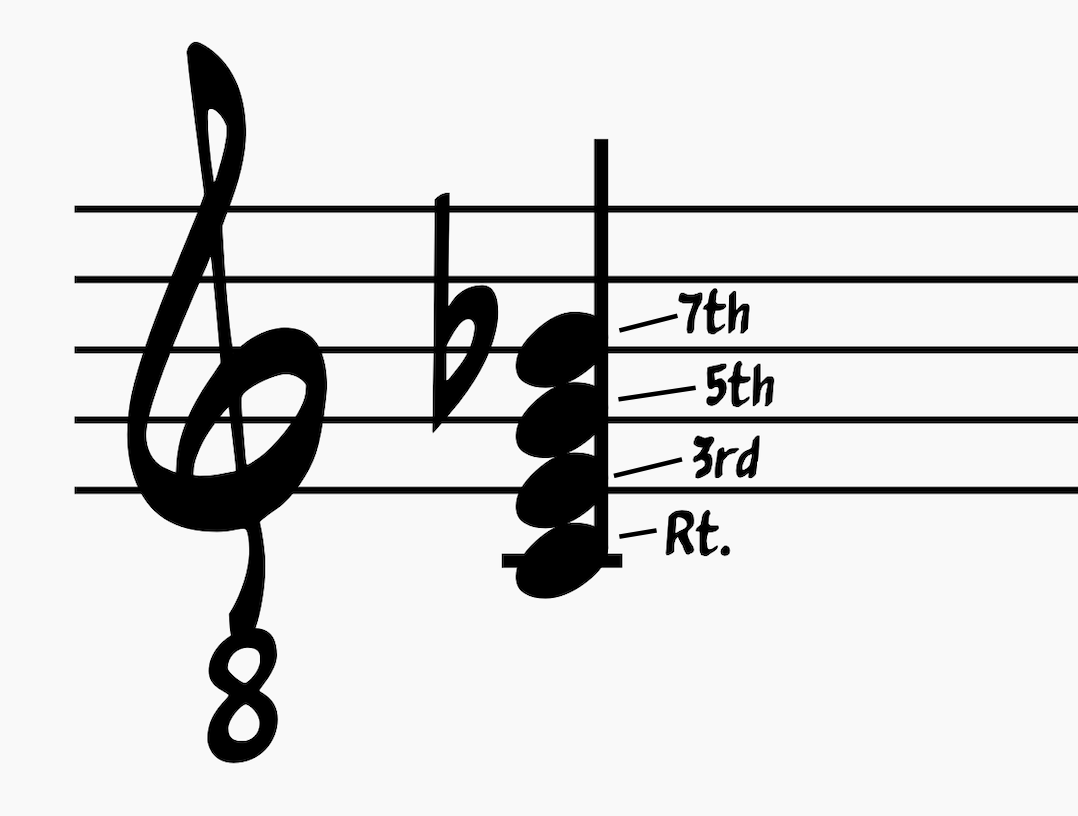
A dominant chord can have a bunch of crazy chord extensions:
- 4th (sus)
- b9th
- 9th
- #9th
- #11th
- b13th
Dominant chords are an essential part of the jazz sound but are also important for other genres, like rock, blues, and classical music. Dominant chords are used by rock, blues, classical, and jazz musicians and composers to resolve chord progressions, change keys, and add the “blue” sound to their music.
The “dominant” sound probably has the most musical applications, especially in jazz. You’ll want to spend extra time on dominant voicings because they are so important to the jazz and jazz blues sounds.
Plus, dominant 7th chords are usually played as extended chords, adding the 9th, 11th, and 13th or altered extensions with:
- a b9th or #9th
- 11th or #11th
- or 13th or b13th
Here are five essential dominant voicings jazz guitarists need to internalize. Check out the chord diagrams:
11. Dominant 7th Chord on E-D-G-B String Group
This is your standard E-D-G-B string group dominant 7th chord shape. Run this shape through all its inversions!
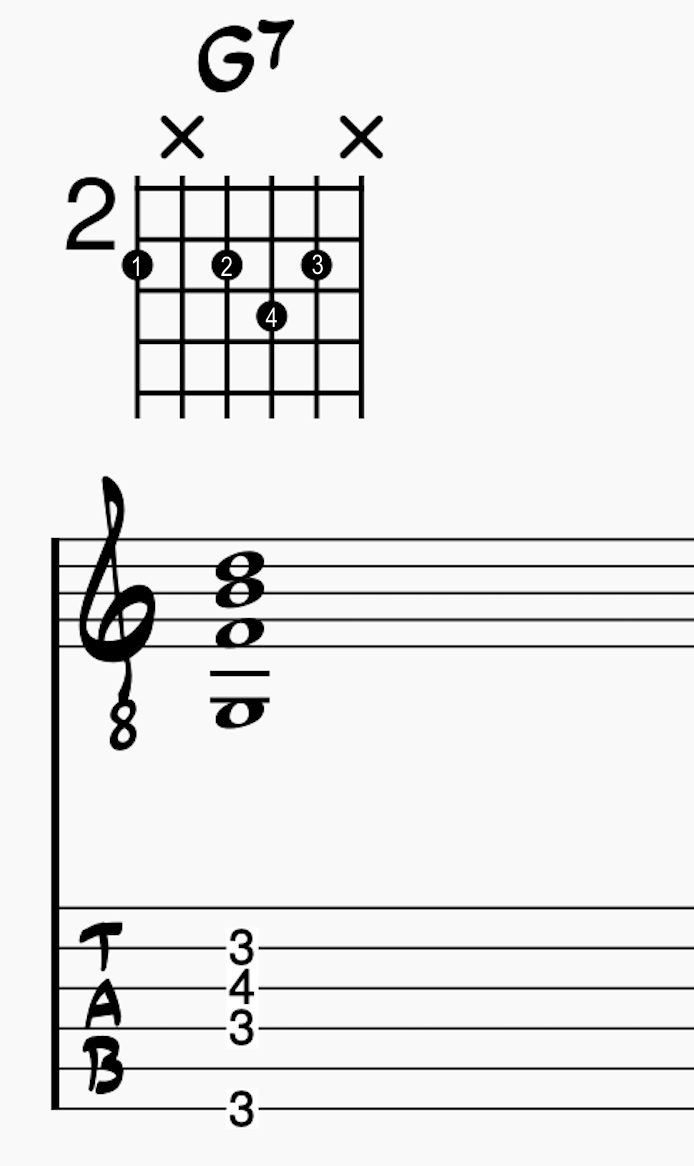
12. Dominant 13th Chord on E-D-G-B String Group
We’ve already seen this jazz guitar chord shape used in an example chord progression above (See: 6. A-D-G-B String Group Minor 9 Chords). This is a great-sounding dominant 7th chord you should internalize!
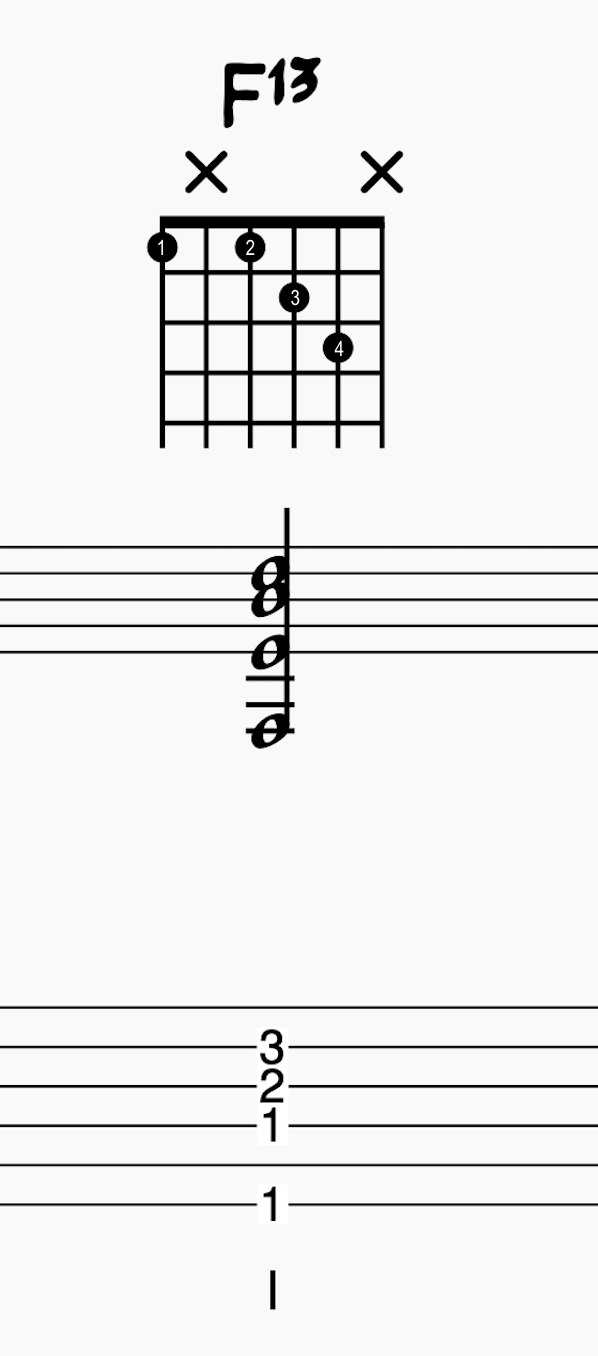
13. Dominant 9th Chord on A-D-G-B String Group
Here is another jazz guitar chord comping staple:
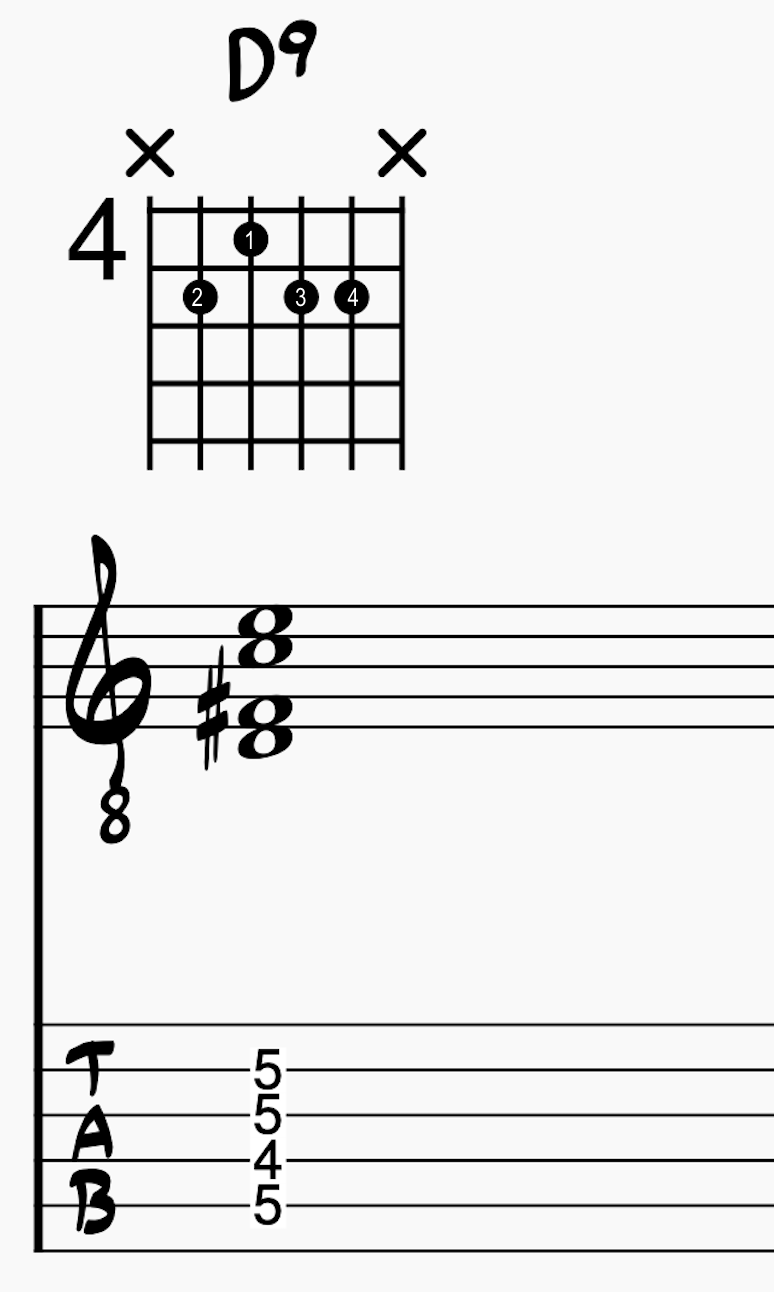
14. Dominant 7th Chord on D-G-B-E String Group
This standard dominant chord shape and its inversions are great for chord melodies because it’s on the D-G-B-E string group, so you can keep the melody note on the top of the voicing as you move up and down its inversions.
Take this dominant chord through all its different chord inversions.

15. Dominant 13th/b9 Chord on the D-G-B-E String Group
This rootless dominant 7th chord shape is great for altered dominant chords with a b9. The natural 13th makes this a suitable choice for altered V chords that resolve to a major I chord (the 13th or 6th of a V chord is the 3rd of its I chord).
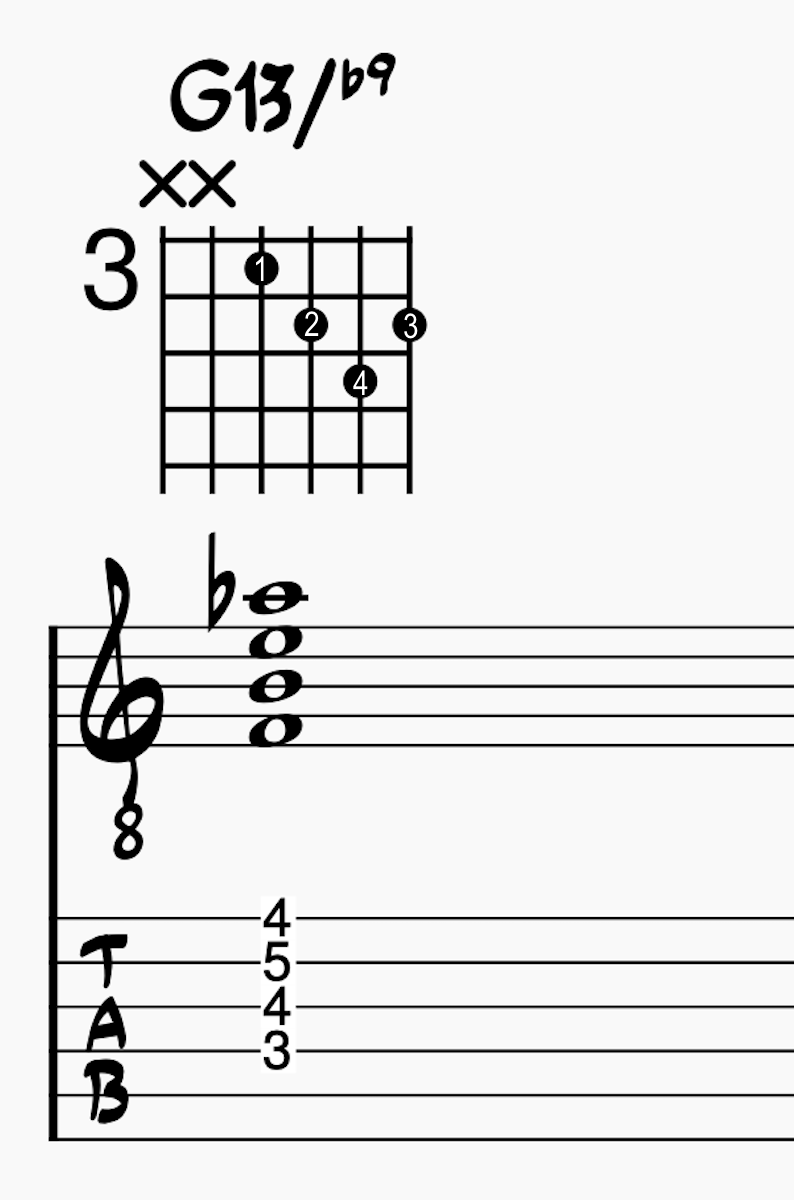
Check out our blog post on dominant 7th voicings and inversions on the guitar, and check out tips for memorizing dominant chords.
Jazz Guitar Chords: 5 Half-Diminished and Diminished Seventh Chords
Half-Diminished Jazz Guitar Chord
Half-diminished chords are built using this formula:
- Root
- minor 3rd
- diminished (or flat) 5th
- minor 7th
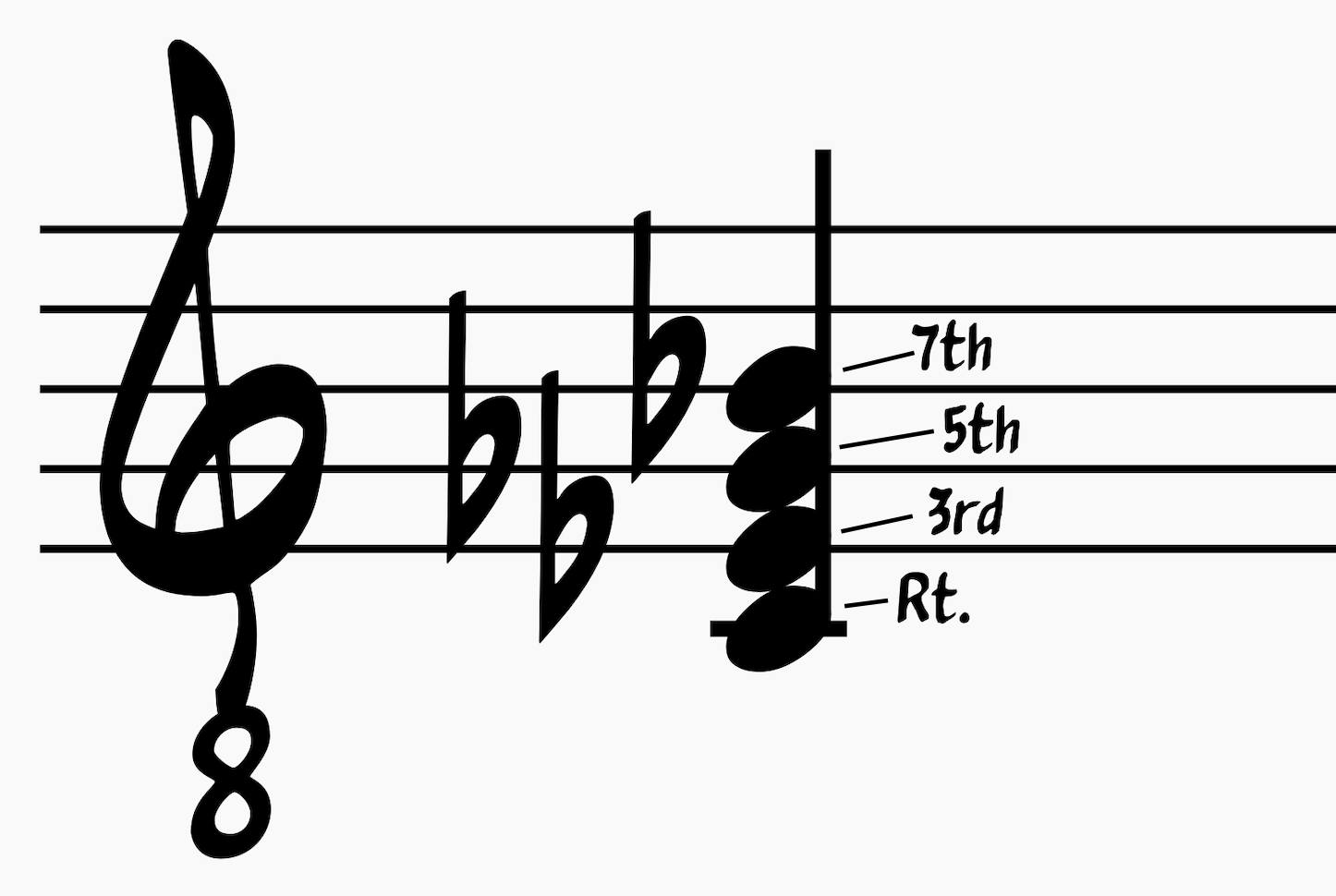
Common extensions for half-diminished chords:
- 9th
- 11th
Fully-Diminished Jazz Guitar Chord
Fully-diminished chords are built using this formula:
- Root
- minor 3rd
- diminished (or flat) 5th
- diminished 7th (enharmonically equivalent to a major 6th interval)
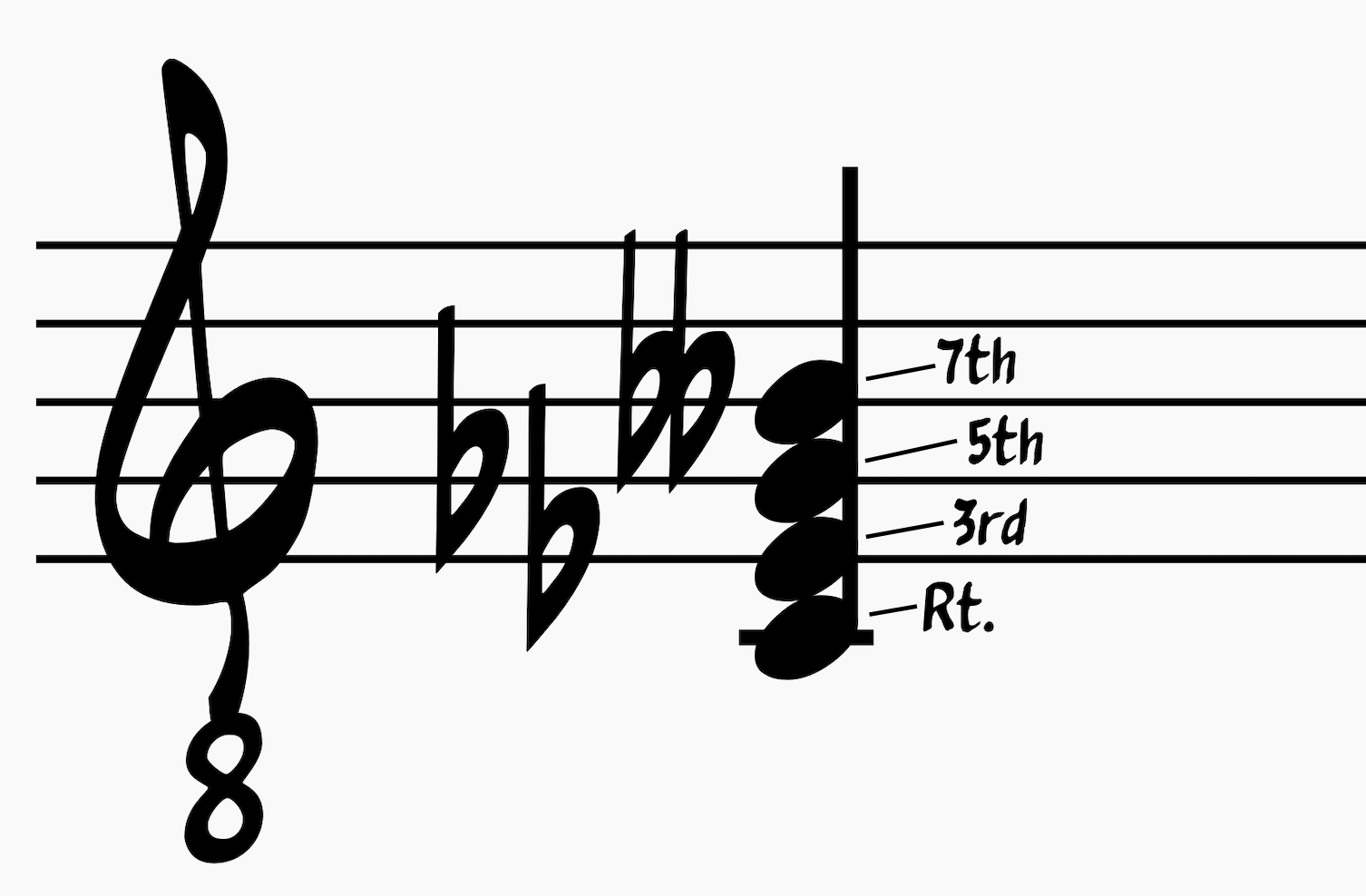
Extensions aren’t commonly used on fully diminished chords.
The m7b5 shape can be derived easily from any minor chord shape. You only need to take the 5th of a minor chord and flat it. You can also consider it a diminished triad with a minor seventh interval from the root note.
To get fully diminished chords, you must take the m7b5 chord and flatten the minor seventh interval to a diminished 7th interval.
Here are essential half-diminished and fully diminished voicings you’ll need to play jazz guitar. Check out the chord diagrams:
16. Min7b5 Jazz Chord on the A-D-G-B String Group
This is a heavily used minor7-b5 voicing you need to know! Definitely take this one through all its inversions.
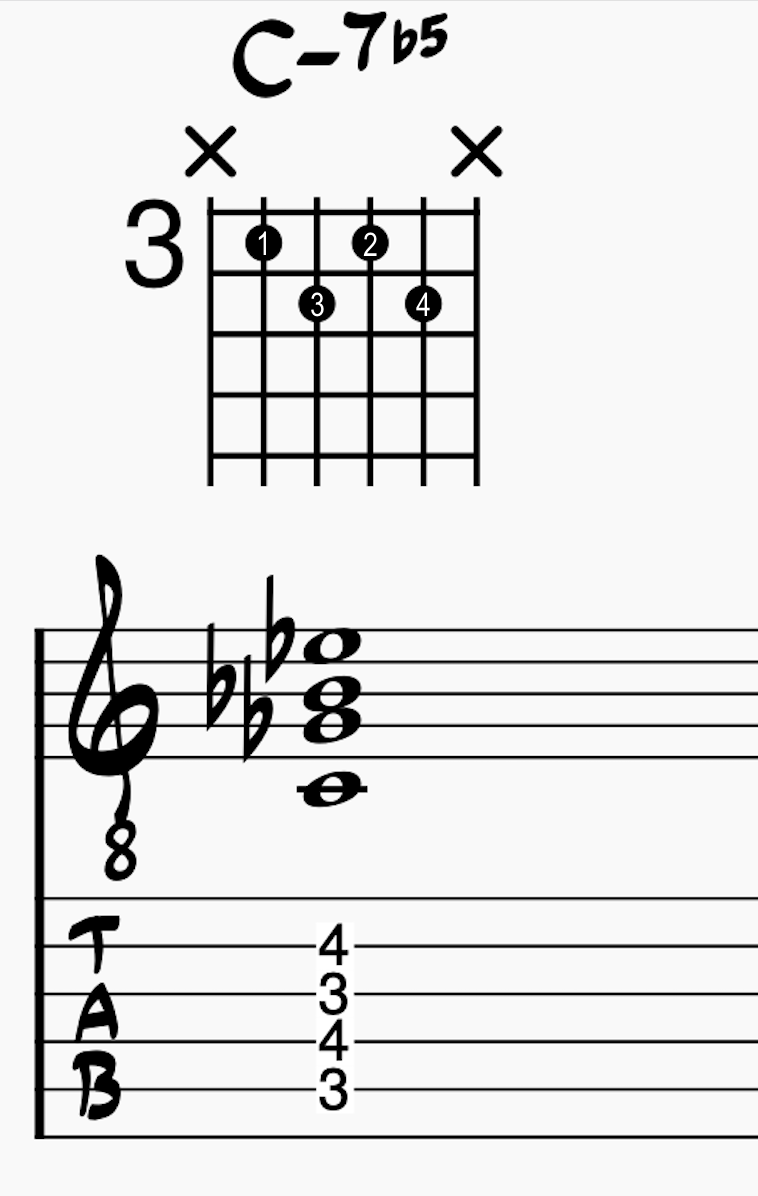
17. Min7b5 Guitar chord on the E-D-G-B String Group
Here is another min7b5 chord shape you should take through all inversions:
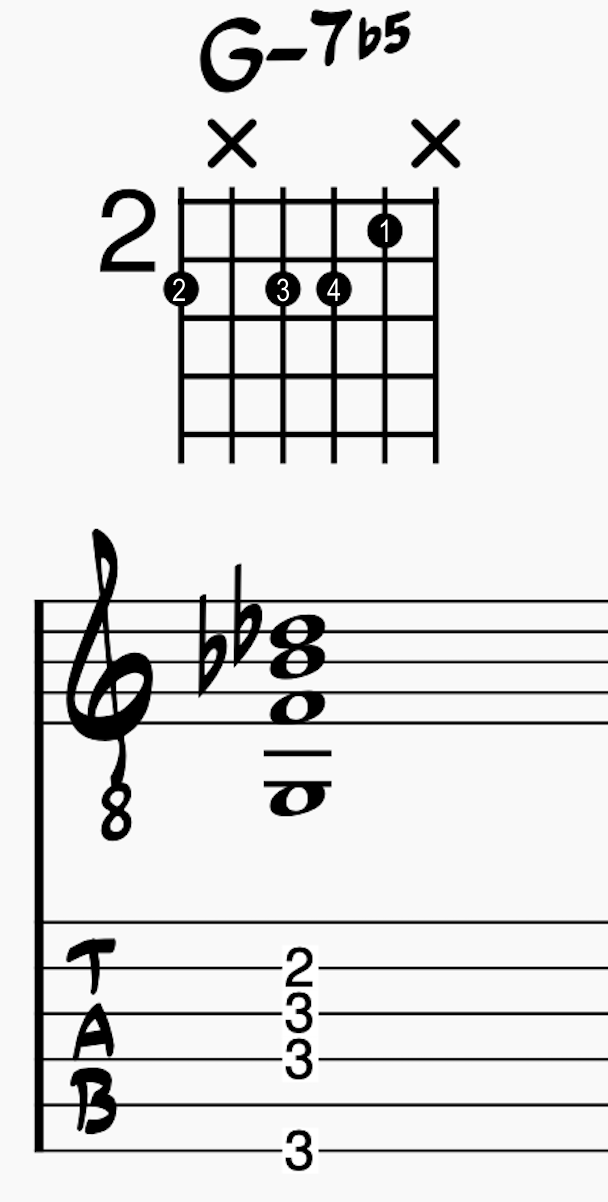
18. Min11b5 Chord on the A-D-G-B String Group
This variation on our first chord shape in this category is an example of an extension you can put on minor 7b5 chords. It’s also the first chord in a cool jazz guitar comping device for a minor ii-V progression.
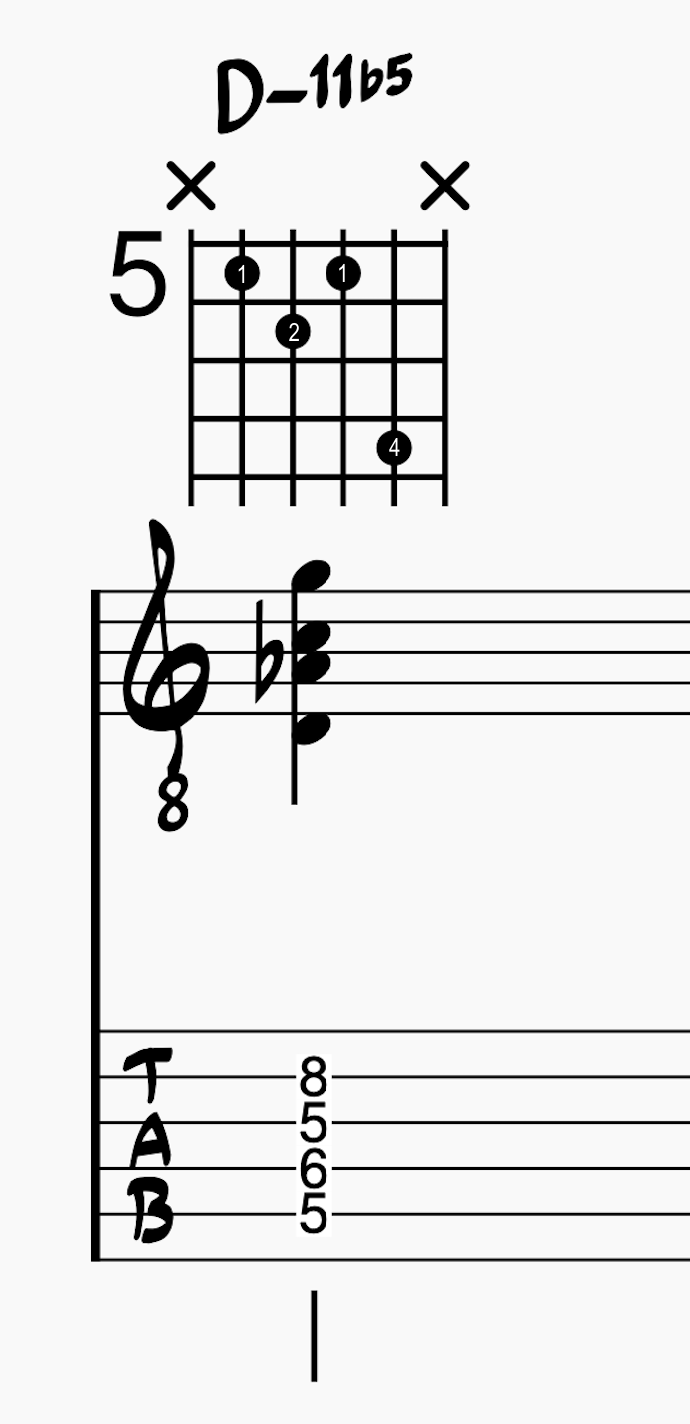
Use this chord shape in the following ii-V-I progression! All you have to do is move the D-11b5 chord shape up a minor third, and you’ll have a G7alt/F chord, which then resolves to Cmaj7/E.
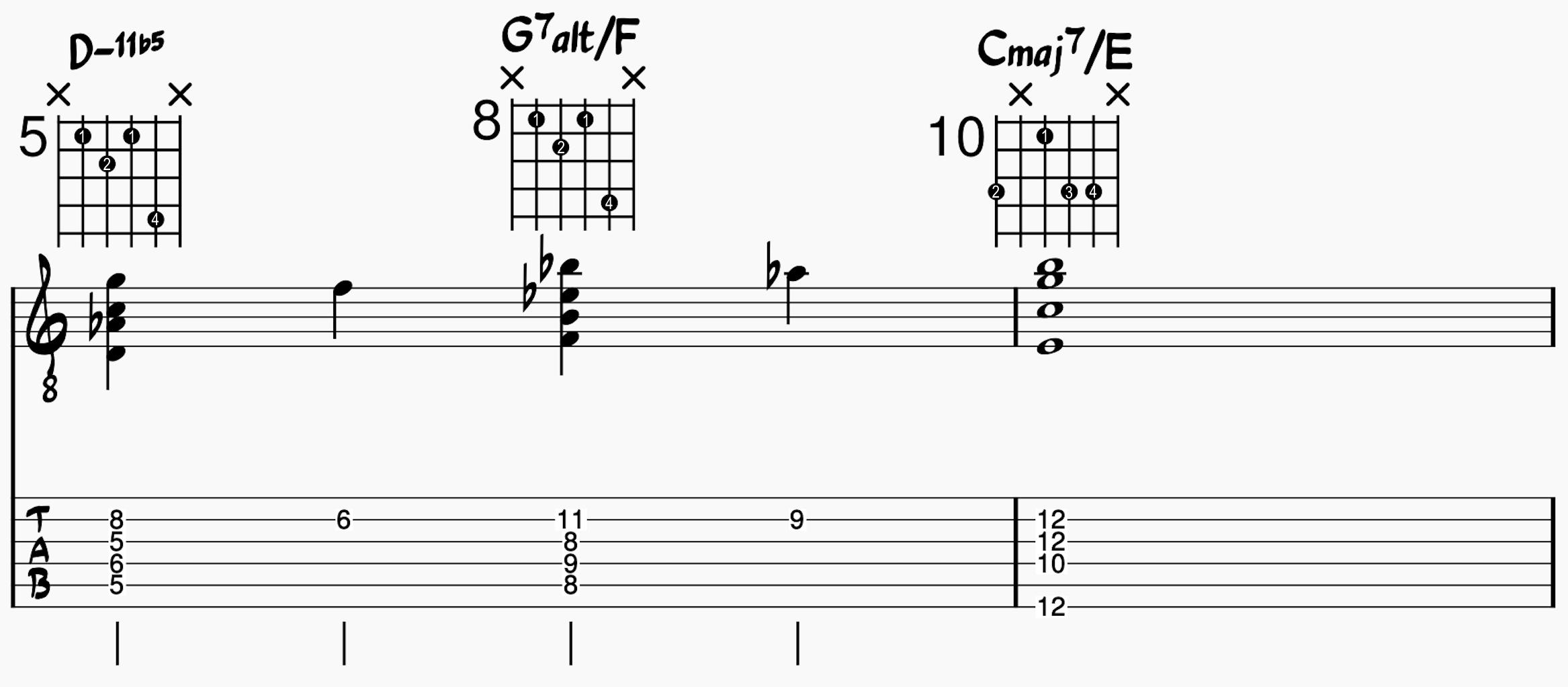
19. Fully Diminished Chord on the A-D-G-B String Group
The next two jazz guitar chords are fully diminished chords on different string groups. Memorize the following jazz chords, too!
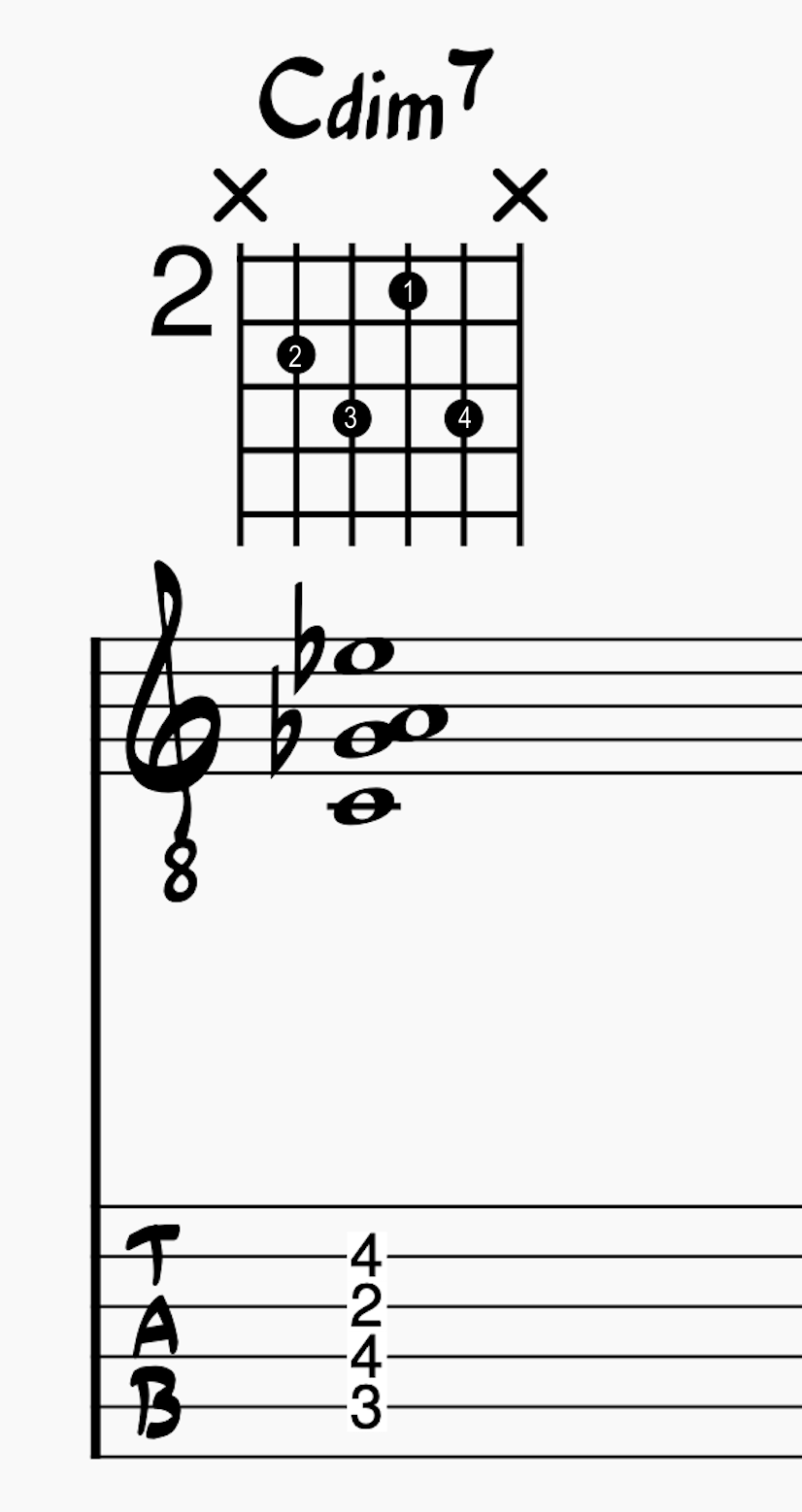
20. Fully Diminished Chord on the E-D-G-B String Group
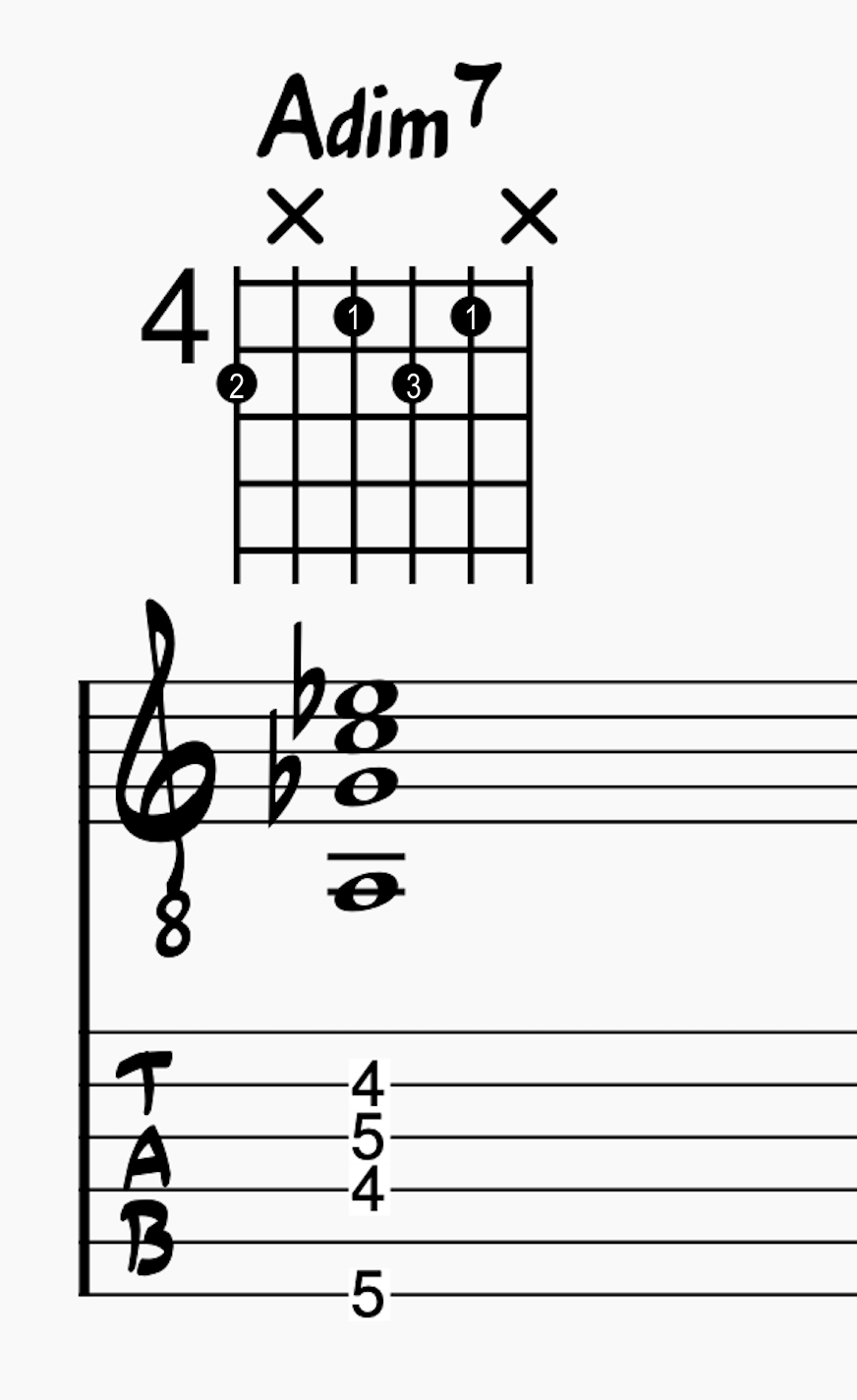
Half-diminished chords are a staple of the minor ii-V-i, found in almost every minor chord progression. Diminished seventh chords have a variety of uses, including passing chords and the v°7 chord in the harmonic minor key.
Check out our blog posts on half-diminished voicings and inversion on guitar and diminished voicings and inversions on guitar.
What Makes Jazz Guitar Chord Voicings Unique?
Applying jazz harmony to the guitar might seem like a daunting task. On a piano, everything is linear: low to high, left to right. There is only one axis of pitch. However, the guitar has two axes of pitch. You can move up the neck to change pitch or move across the strings.
At first glance, this seems like an unnecessary complication. But it’s a feature and not a bug. As jazz guitarists, we can play the same notes on different strings, enriching chords with unison pitches and different timbres.
This means there are several chord shapes for the same chord voicing.
Additionally, jazz guitarists can break the twelve-tone system by bending notes. By doing so, they access the microtonal sounds present in the blues.
Jazz Chord Practice Tips For Every Jazz Guitarist (and General Jazz Chord Advice for Aspiring Jazz Musicians)
Now that you have some basic jazz guitar voicings for all these chords, where do you go from here?
With music, the more you learn, the more you realize there’s more to learn! Once you feel comfortable with these voicings, there are so many things you can do to develop your own approach to jazz music. Once you have the tools, you must develop your own jazz sound.
This can involve several things depending on your musical goals—
- Improve your music theory knowledge
- Improve your musicianship through ear training
- Build up your jazz repertoire by learning jazz standards
- Shed the comping styles and solos of jazz guitar legends
- Start practicing solo jazz guitar and learn a chord melody
If you are ready to take your guitar playing to the next level, check out our comprehensive article that covers everything you need to know to play jazz guitar.
In that article, you’ll learn how to take some of these easy jazz chords through their inversions all over the neck. You’ll also learn how to start applying these major chords, minor chords, and other chords in common jazz progressions.
Improve Your Jazz Music Theory Knowledge With Jazz Chords
Improve your understanding of major and minor triads, scales, chord scales, and chord-scale relationships. Chords and scales are two related ways of organizing the same musical information and relationships.
For example, here is a major scale harmonized in triads. The original scale is in color:

This chord scale contains three basic chord types:
- Major chord: three major triads
- Minor chord: three minor triads
- Diminished chord: one diminished triad
Let’s convert this triad chord scale into a seventh-chord chord scale:

This chord scale contains four different types of seventh chords:
- Major 7th Chords (in red)
- Dominant Seventh Chords (in green)
- Minor Seventh Chords (in yellow)
- a Minor Seven Flat Five Chord (in purple)
Harmonized scales aren’t limited to the major scale. We have to harmonize different minor scales to find altered and fully diminished chords.
Here is the melodic minor scale harmonized in 7th chords:

Understanding the major scale helps us learn jazz chords, jazz chord progressions, and chord scales.
For more information on important jazz chord progressions, check out our article on 9 jazz chord progressions you need to know.
Improve Your Musicianship Through Ear Training
Well-trained jazz musicians have a deep aural understanding of the interval relationships that make up jazz voicings. They can hear a guitar player play chords, and they’ll be able to tell you their quality even without having a perfect pitch.
To play jazz in the moment, you’ll need to rely on your ear more than your eyes!
You need to develop your ear to understand the musical context of a chord or line or to hear the rhythm sections and soloists’ interplay. You’ll need to listen to the chord changes as they happen.
Apart from memorizing these shapes physically, you need to learn them aurally. There are many ways to do this, but a great way to start is to be able to sing the chords as an arpeggio.
Play one note on your guitar, like the root or the 5th, and sing the rest of the voicing. This exercise will help you internalize pitch relationships, and your musicianship will skyrocket.
Try identifying chord progressions by listening to your favorite recordings. If that is too challenging, try identifying chord qualities and progressions in backing tracks, which often have simpler voicings and comping patterns.
Build Up Your Jazz Repertoire
The best way to learn jazz is to play jazz. Jazz standards are the canvases that jazz musicians paint sounds on. Learning jazz standards will improve your knowledge of chord progressions, help you get better at playing melodies, and improve your jazz solos.
Plus, it’s a crucial first step for learning how to play solo guitar.
There are many types of jazz standards:
- American Songbook Standards
- Modal Jazz
- Bebop
- Jazz Blues
- Jazz Waltz
- Bossa Nova
- Latin Jazz
If you want to learn how to approach playing chord progressions and learning jazz standards, check out our Learn Jazz Standards The Smart Way Guide.
Shed the Comping Styles, Chord Voicings, and Solos of Jazz Guitar Legends
It’s important to know a bit about the key jazz guitar players who pushed jazz guitar forward throughout and beyond the twentieth century. Note that many of the following guitarists lived through several eras of jazz guitar and played in many styles. This list is just intended as an introduction to key guitar players you need to check out.
Early Jazz / Swing Era (1920s-1930s):
This period marked the beginning of jazz guitar, characterized by rhythm guitarists playing chordal accompaniment (with the occasional guitar solo sprinkled in).
Key Players:
- Eddie Lang
- Freddie Green
- Django Reinhardt
- Charlie Christian
Bebop Era (1940s-1950s):
During this era, guitarists began playing more intricate solos, often influenced by bebop giants like Charlie Parker, which featured rapid, chromatic lines and complex harmonies.
Key Players:
- Charlie Christian (pioneering figure)
- Barney Kessel
- Tal Farlow
- Jimmy Raney
Cool Jazz / West Coast Jazz (1950s-1960s):
Cool jazz was laid-back and emphasized a more melodic, lyrical approach to playing than in earlier eras.
Key Players:
- Jim Hall
- Wes Montgomery
- Johnny Smith
- Joe Pass
Fusion Era (Late 1960s-1970s):
Fusion mixed jazz with rock, funk, and other music genres, resulting in unique playing styles and new sounds.
Key Players:
- Larry Coryell
- John McLaughlin
- Pat Metheny
- Al Di Meola
Post-Fusion / Modern Jazz Guitar (1980s-Present):
Modern jazz guitar has many styles, including traditional jazz, avant-garde, and world music.
Key Players:
- Bill Frisell
- Kurt Rosenwinkel
- John Scofield
- Mike Stern
- Julian Lage
Use These Jazz Chords To Play Solo Jazz Guitar and Learn a Guitar Chord Melody
Unlike other instruments, the guitar and piano (and double bass!) can play chord melodies. For those who don’t know, chord melodies are exactly what they sound like—a single chordal instrumentalist who simultaneously plays a tune’s melody and harmony.
This practice is much more common for piano, but jazz guitarists have also incorporated chord melodies into the jazz guitar paradigm.
Though present in folk, bluegrass, blues, and occasionally in rock (hello, Steve Howe), chord melodies are most prominently played by jazz guitarists. A working knowledge of harmony (being able to play lines and chords through any common chord progression), voice leading, and chordal improvisation are essential prerequisites to playing the melody and harmony of a jazz song simultaneously.
Start arranging your own jazz guitar chord melody by learning these three jazz guitar chord melody techniques. Also, check out our video on how to play a chord melody on a jazz standard to get started on your first song.
After you get a few chord melodies under your fingertips, you can begin improvizing in the idiom, which is a very rewarding experience—whether you play an electric guitar or acoustic guitar or already own a bunch of jazz guitars.
Join The Inner Circle To Play Jazz Guitar Like Your Favorite Jazz Guitar Players
If you have spent countless hours in the practice room playing tons of jazz but not improving, you’re not alone. Many guitarists practice long hours and spend good money on guitar lessons.
But many don’t know that practicing jazz itself is something that you need to practice.
By not practicing correctly, these musicians waste a bunch of time working on the things they can play and never progressing on the things they can’t.
If you feel this describes you, it’s time for a change.
Ready to overhaul how you practice?



